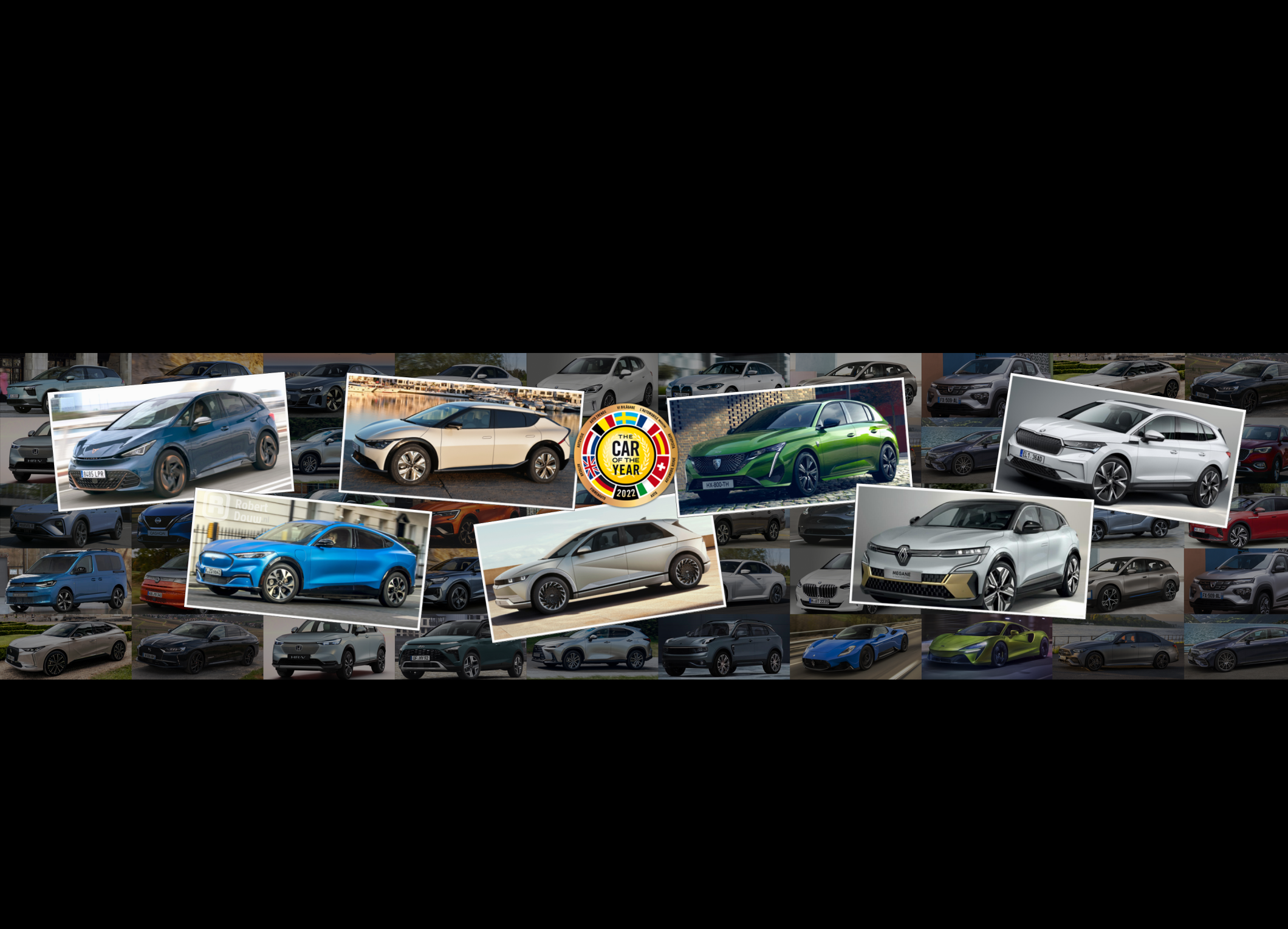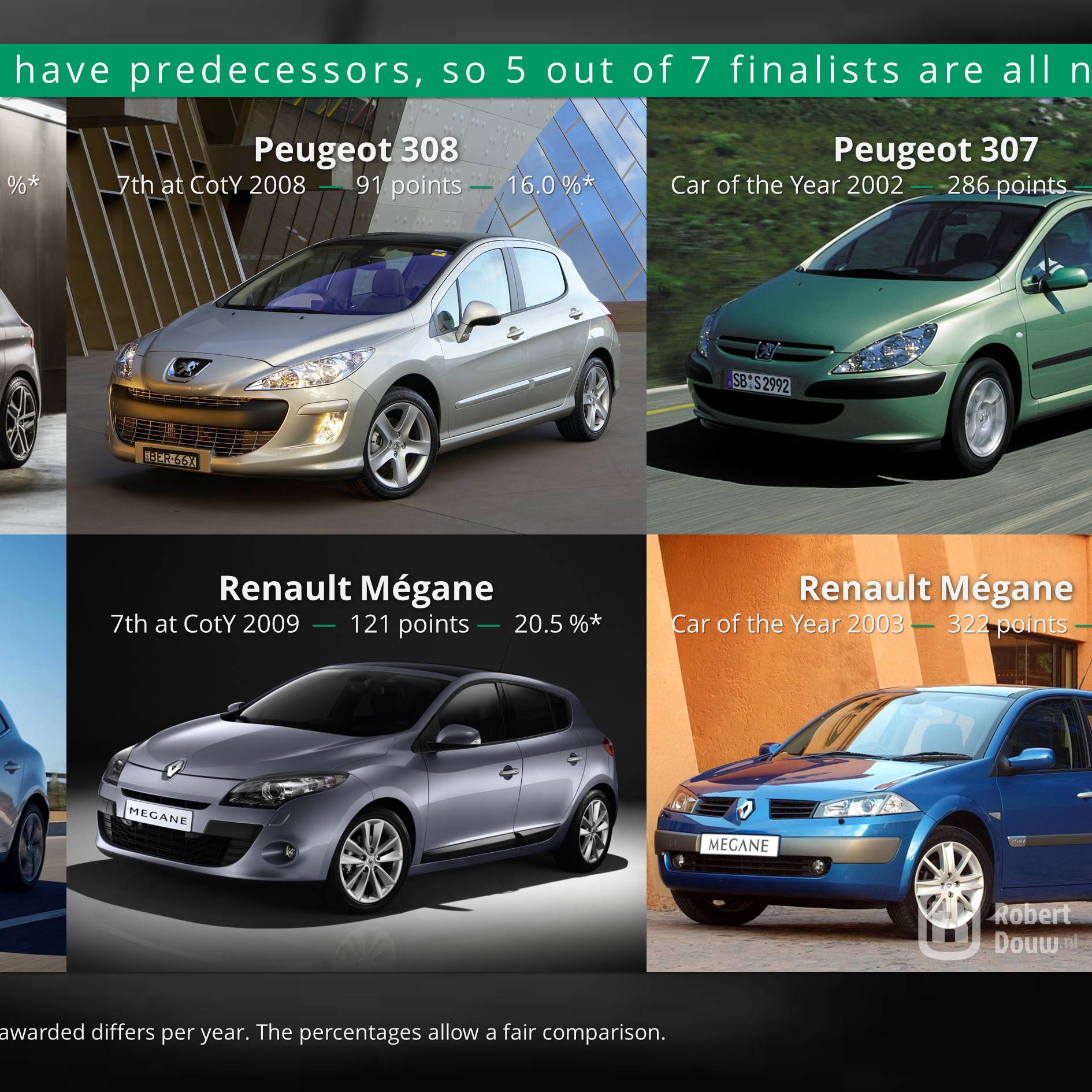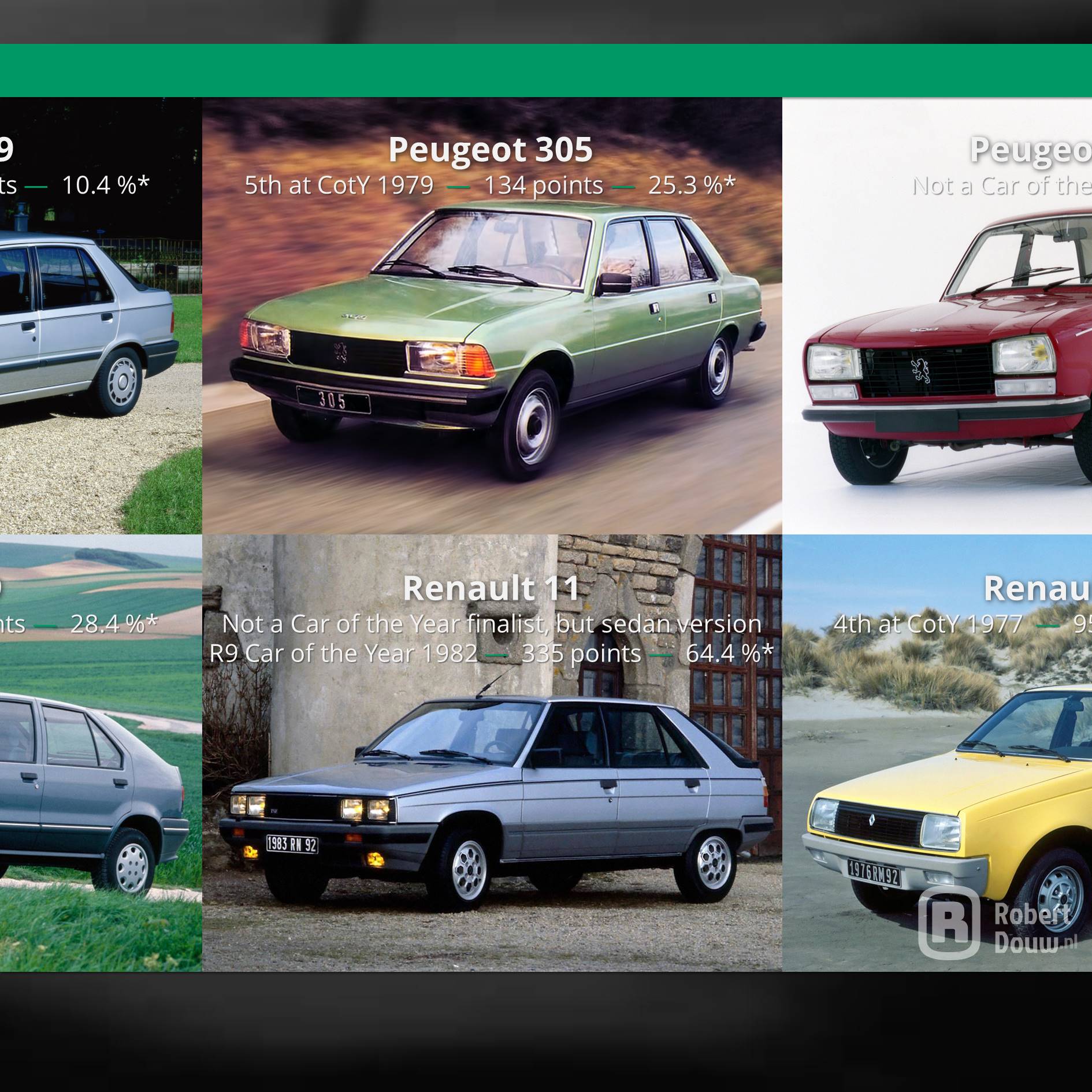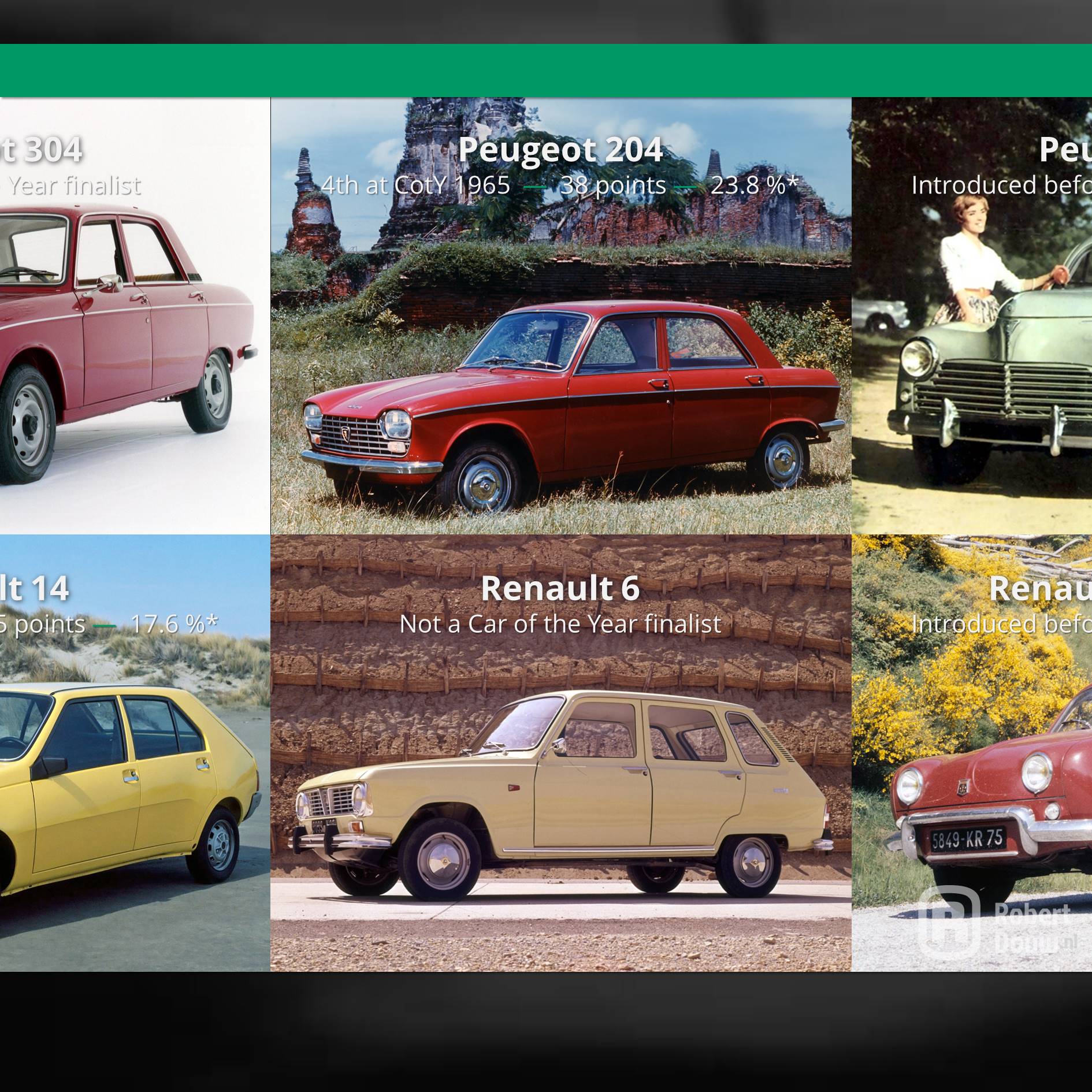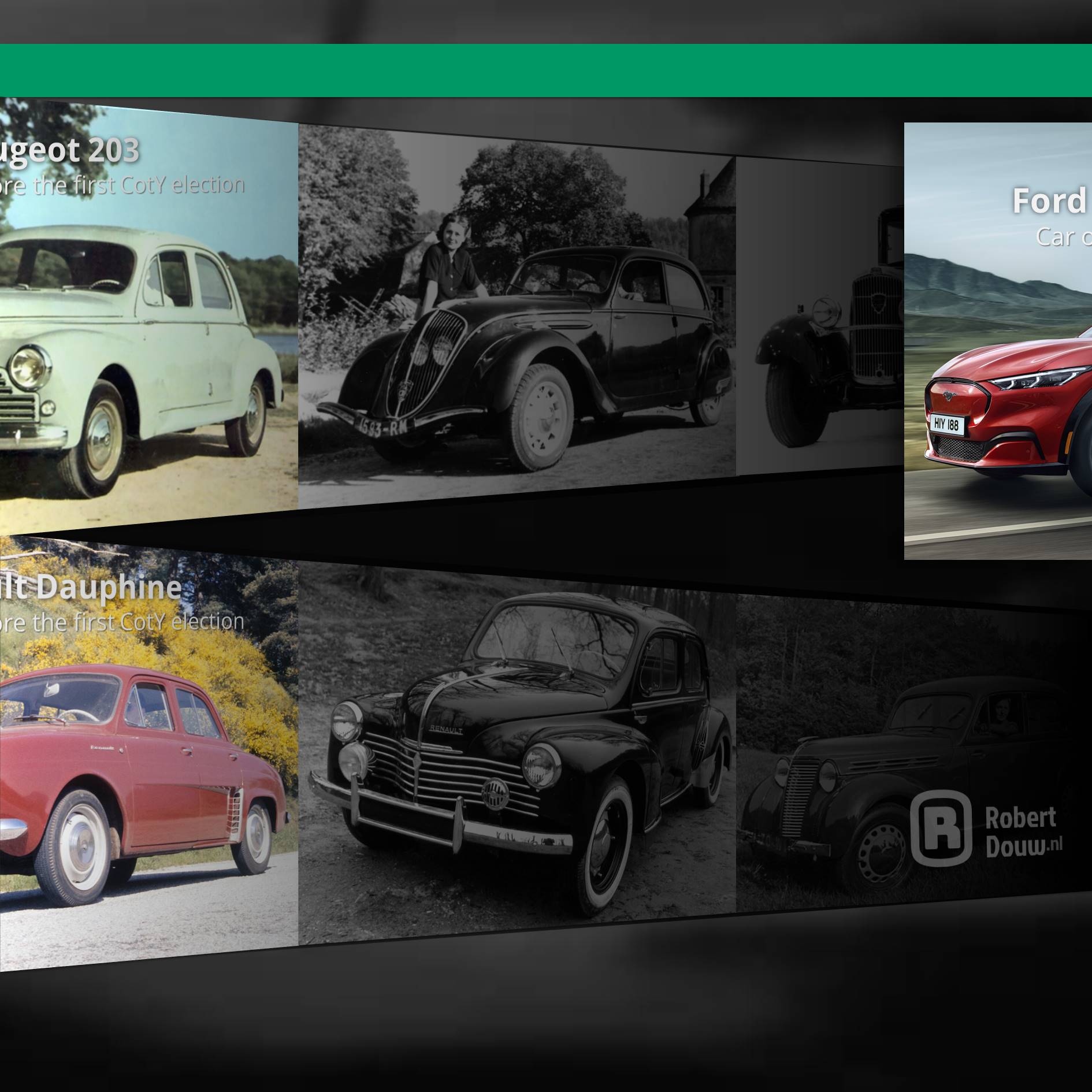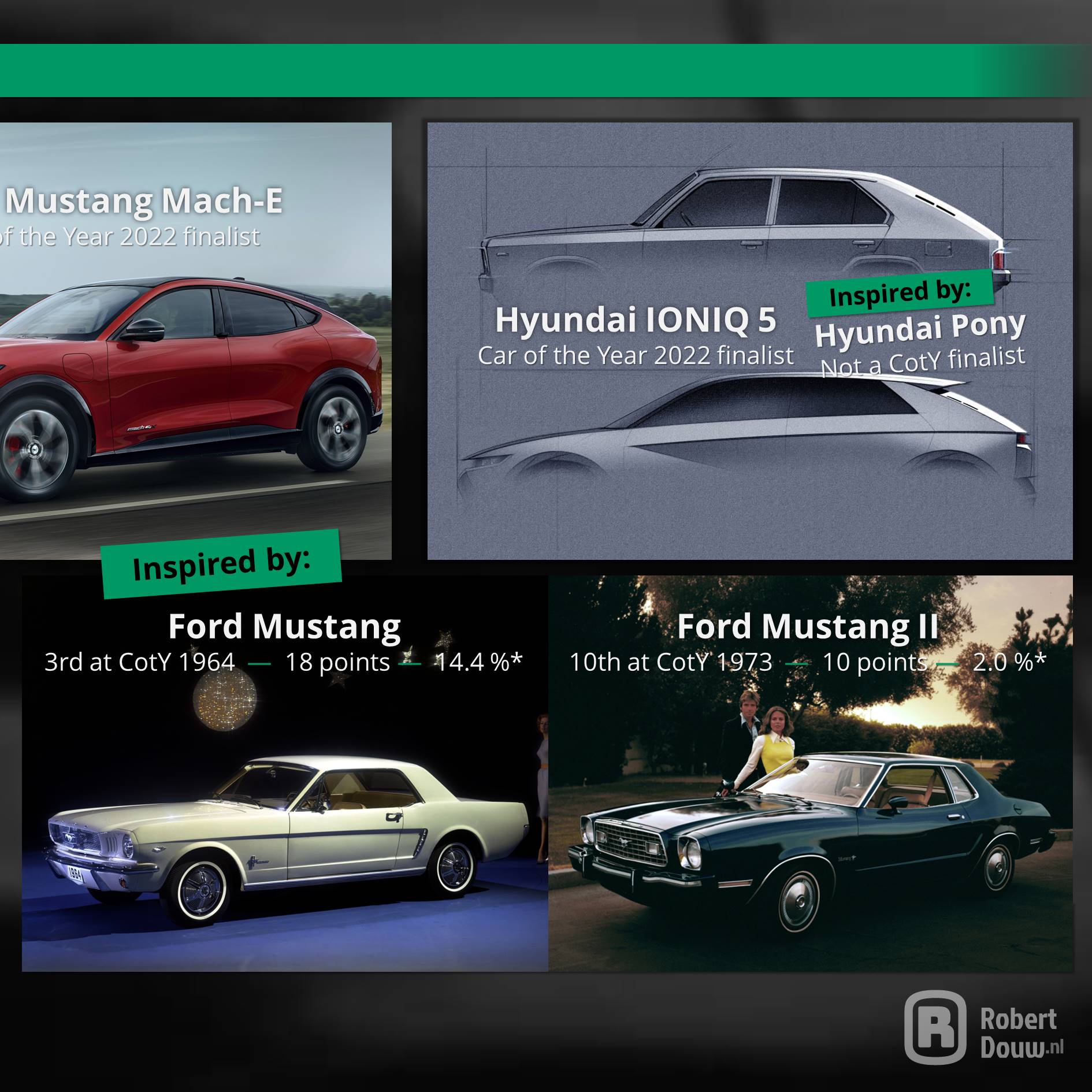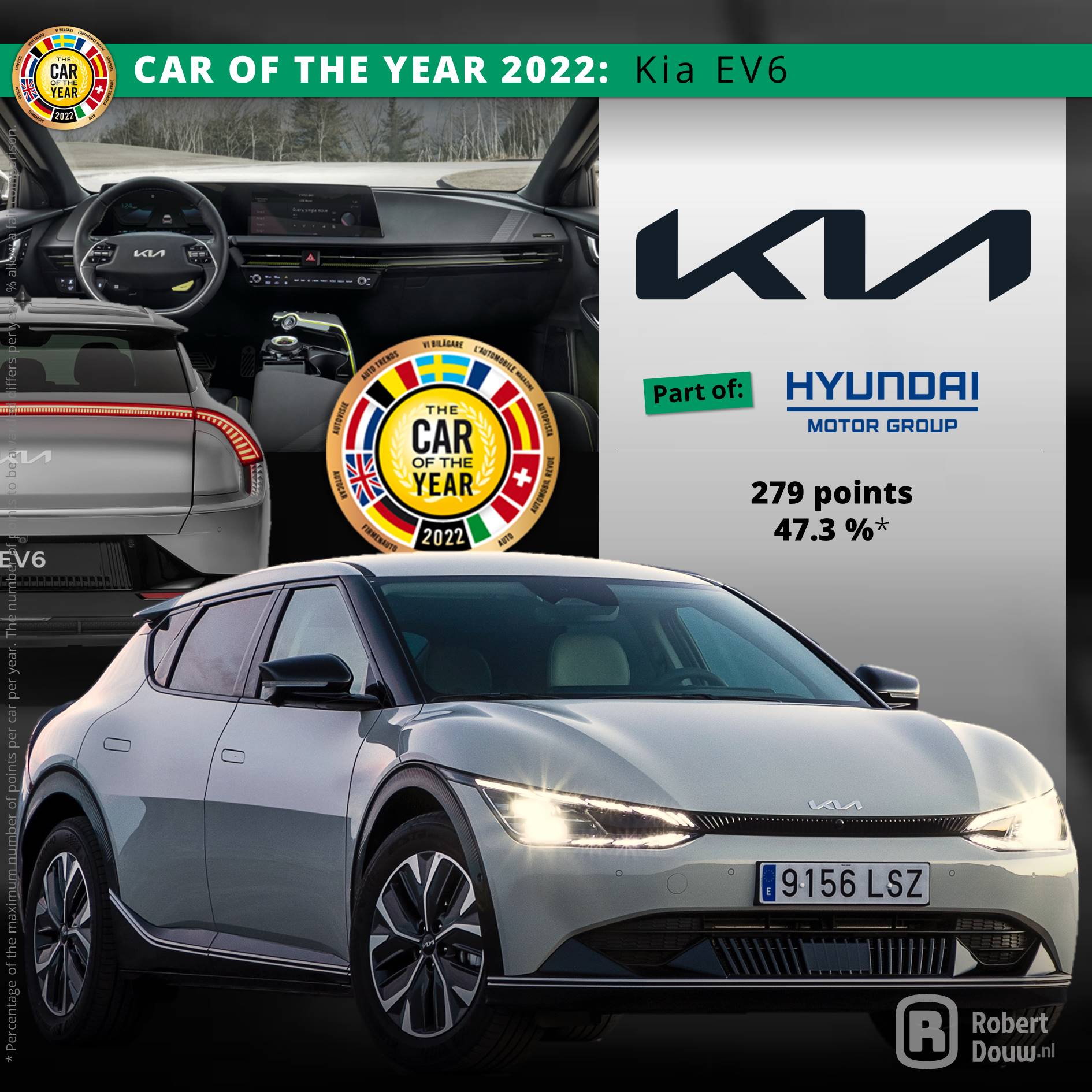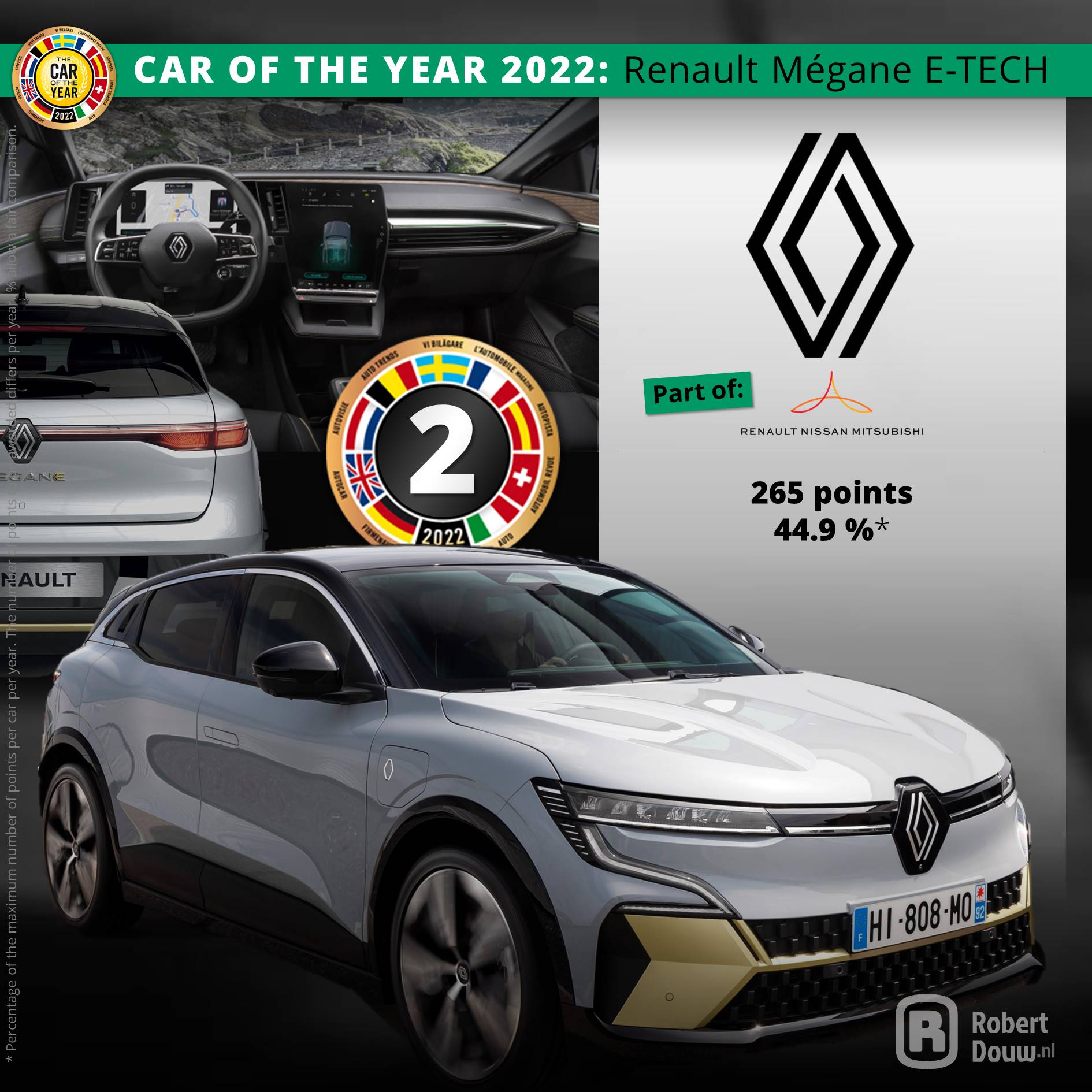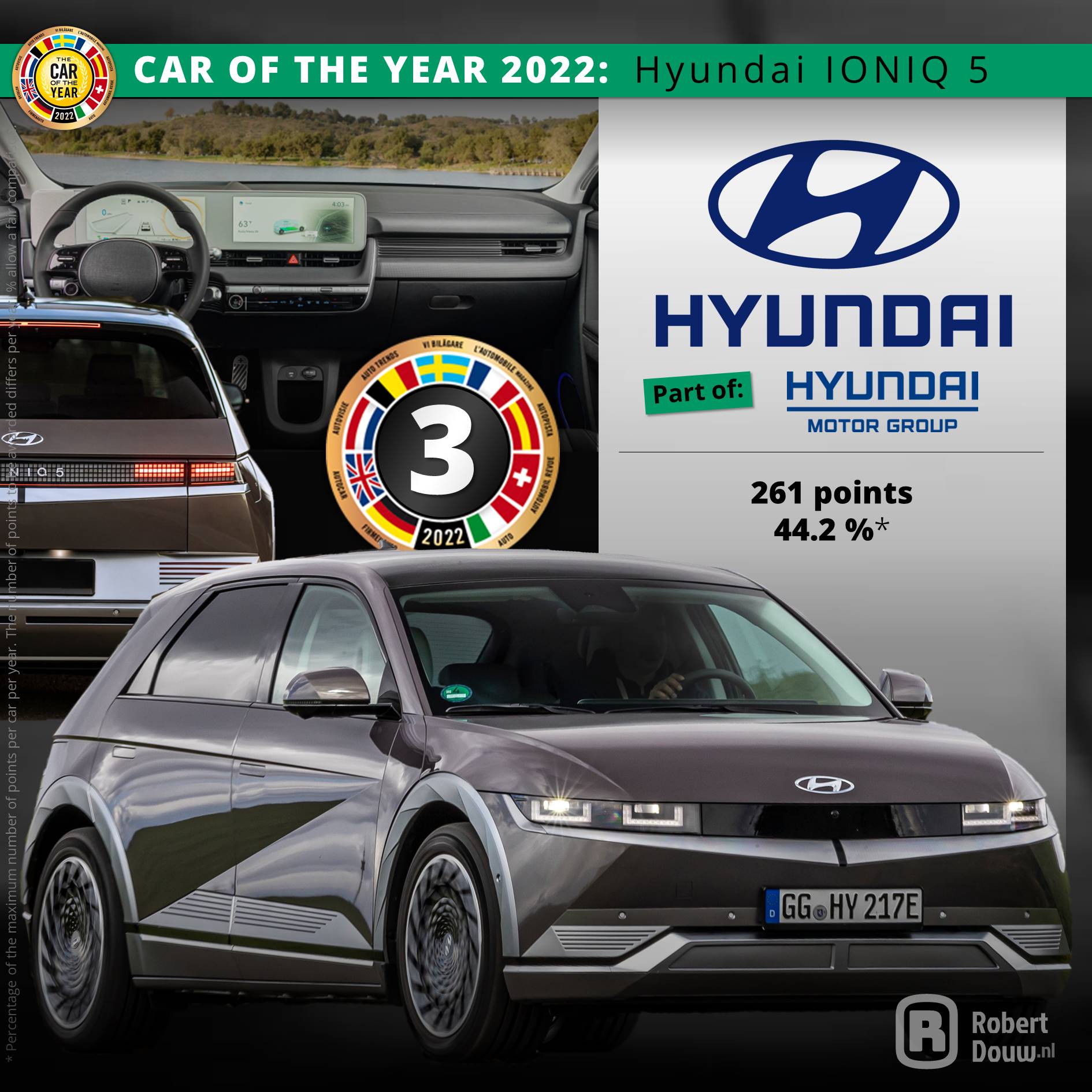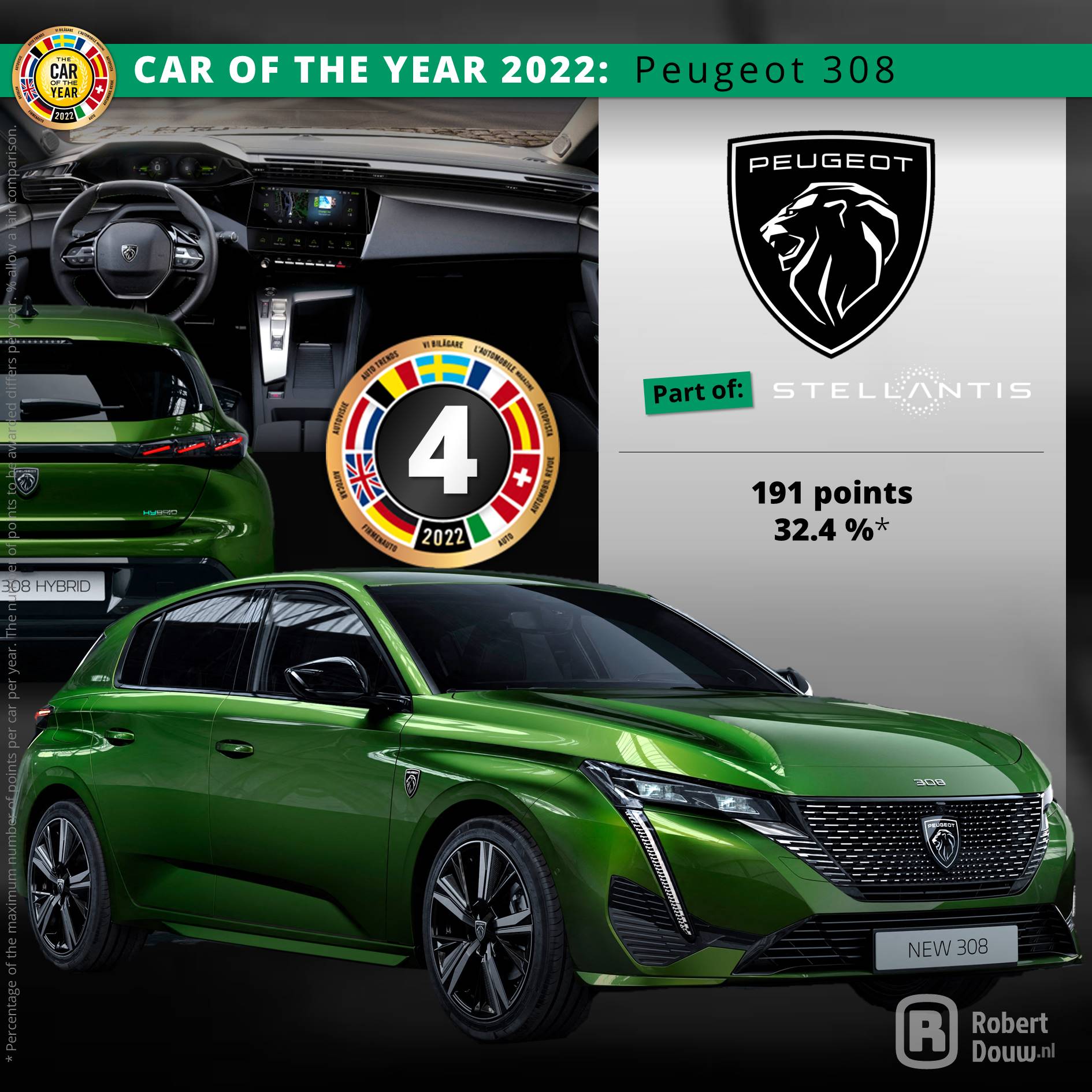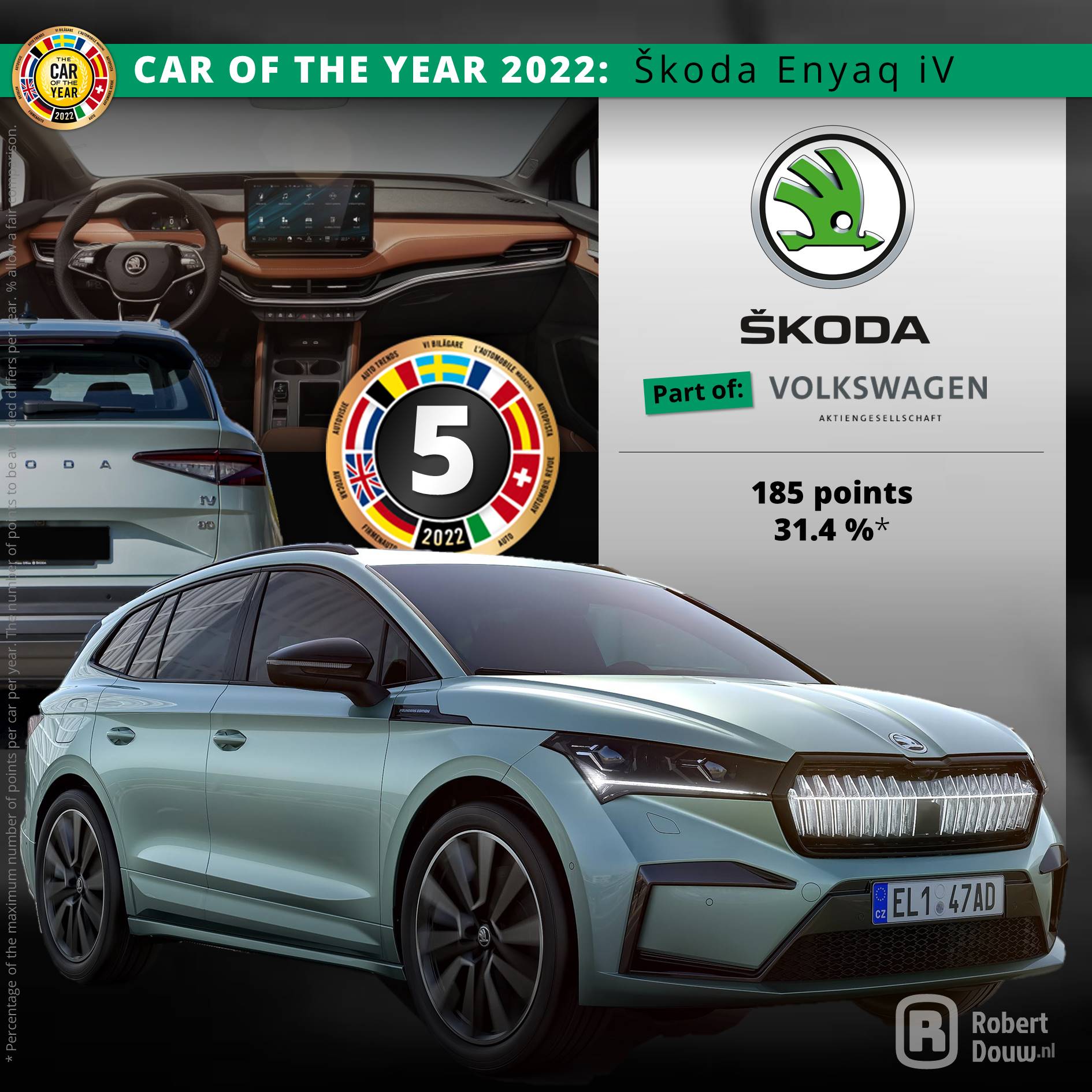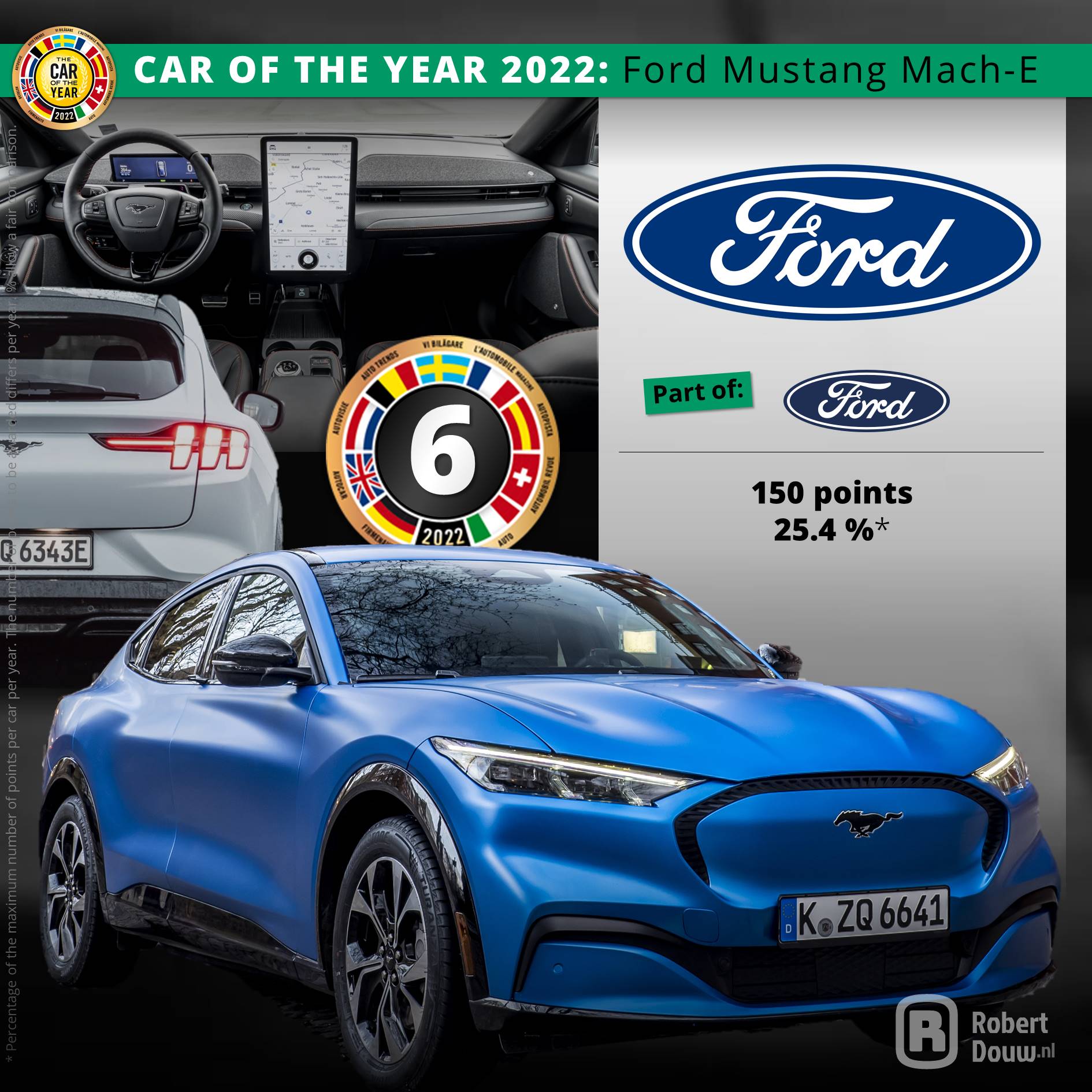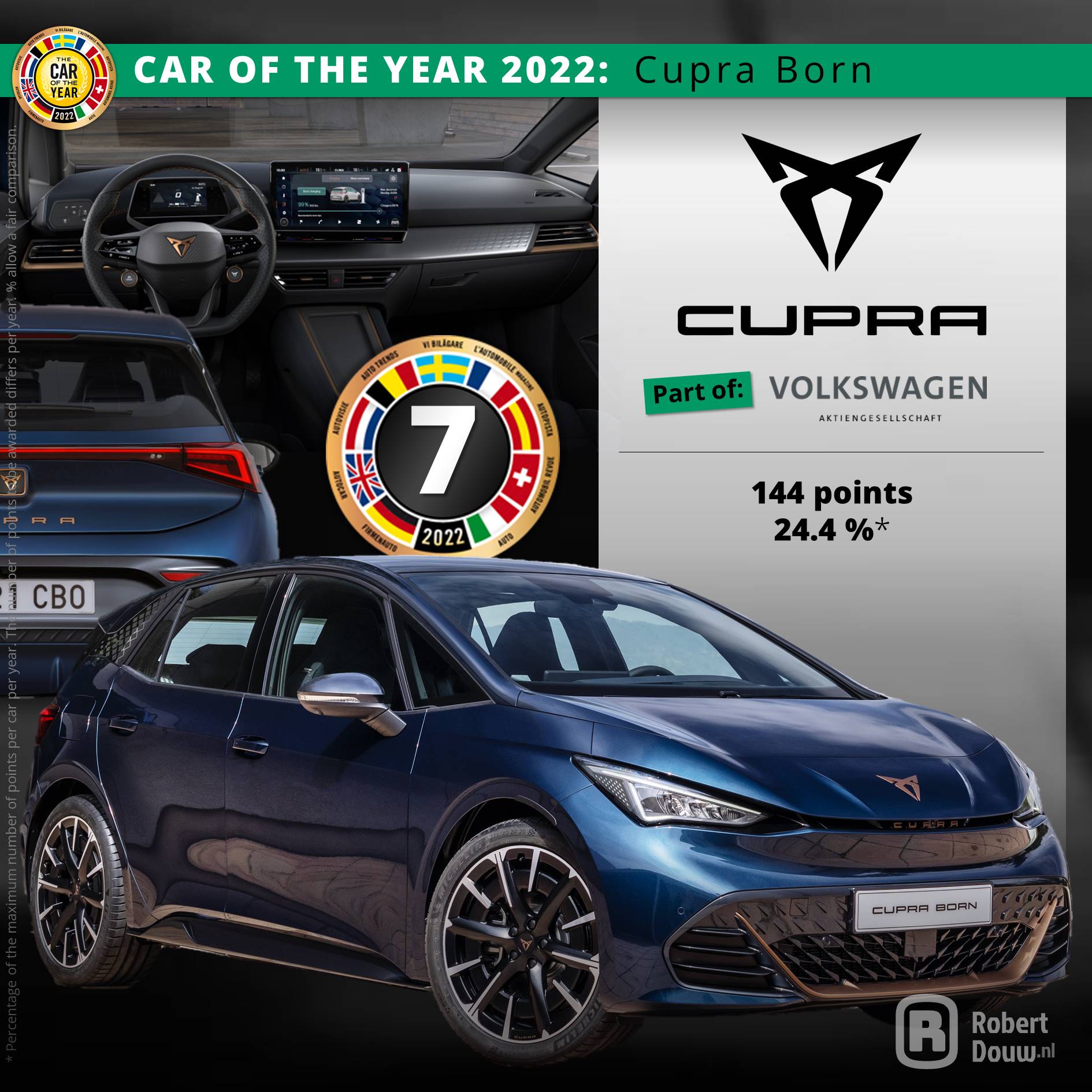CAR OF THE YEAR 2022
From longlist to shortlist —— Nothing Japanese, German, Chinese or Italian —— Seven cars, five platforms —— Drive: almost all electric —— All five-door cars —— Only 308 and Mégane have predecessors —— Cupra: 2nd own design, 2nd finalist —— Ford: six times in the CotY Top 50 —— Hyundai and Kia: first winner from South Korea? —— Peugeot: three recent models are CotY —— Renault: MPV, hatchback, crossover —— Škoda: he who laughs last... —— The winner!
CAR OF THE YEAR 2022
From longlist to shortlist
Cars
| 29-11-2021
On November 29, the organization of the Car of the Year 2022 announced the shortlist for that election. The longlist of - eventually - 39 cars was reduced to seven finalists. The most striking things concerning that list:
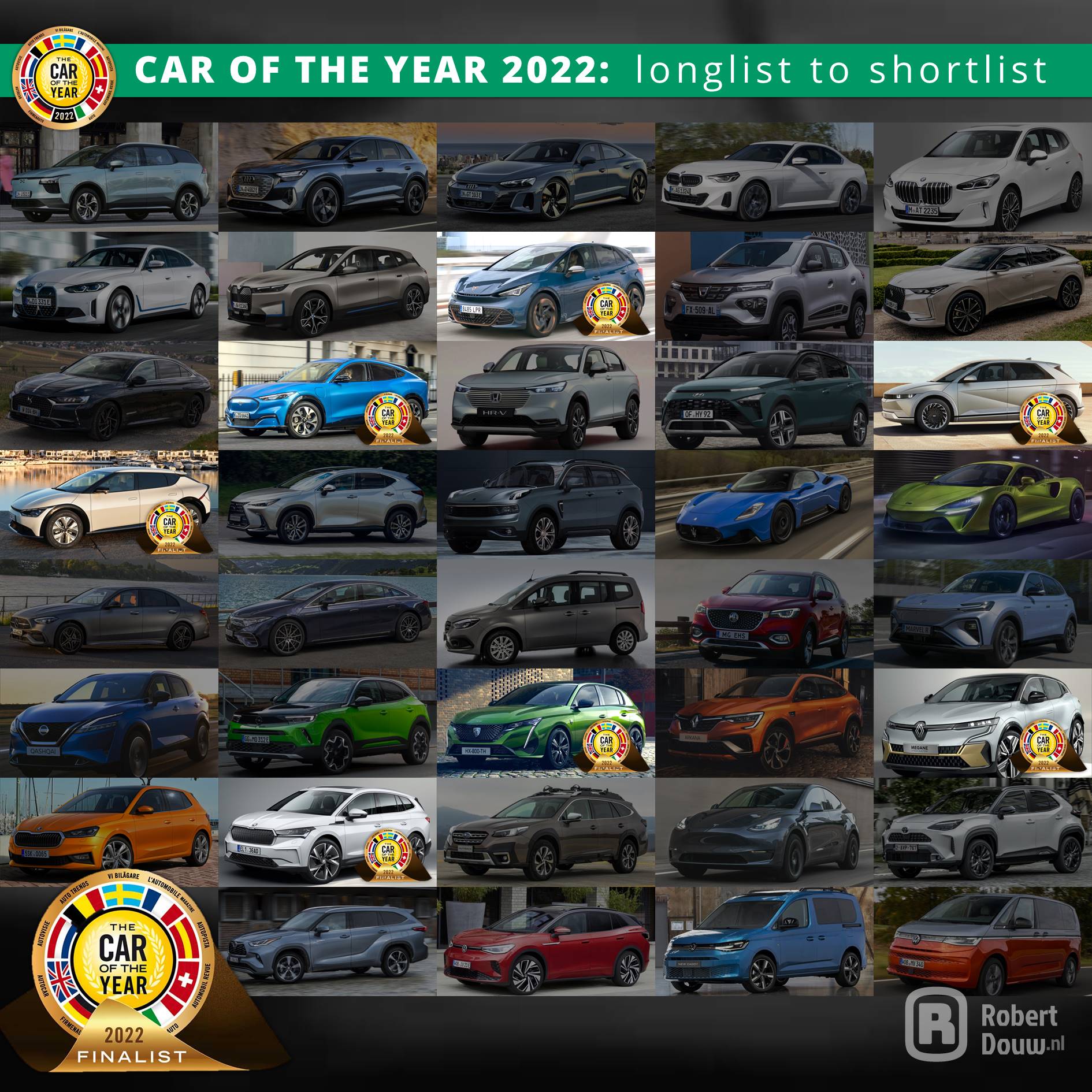
- - Of the four BMWs on the longlist, not one made it to the shortlist.
- - Other "premium brands" — Audi, DS, Lexus, Mercedes-Benz — were also not nominated. Not even the Mercedes-Benz EQS.
- - The Volkswagen ID.5 is not a finalist, platform brothers Cupra Born and Škoda Enyaq iV are. The same applies to the DS 4 (no nomination) and Peugeot 308 (nomination).
- - The predecessor of finalist Peugeot 308 is Car of the Year 2014. The 308 could therefore win twice in a row.
- - The technically closely related Hyundai IONIQ 5 and Kia EV6 are both finalists; apparently they differ enough.
- - The other finalists are the Ford Mustang Mach-E and the Renault Mégane E-Tech. This means that six of the seven finalists are fully electrically powered cars. The 308 has no electric drive, but it is available as a Plug-in Hybrid.

CAR OF THE YEAR 2022
Nothing Japanese, German, Chinese or Italian
Cars
| 05-01-2022
The origin of some brands is a bit difficult to determine, but it is clear for the seven finalists: Spain, the United States, twice South Korea, twice France and finally the Czech Republic. And that is very remarkable for a car election. The two largest car companies are from Japan and Germany, as are many other leading brands.
If you look at the longlist for the Car of the Year 2022, you can clearly see just how remarkable it is. Thirteen of the 39 cars on that list are of German origin - not one of them made it to the final. Six of the 39 are of Japanese origin - none of them are in the final either.
If you look at the origin of all car brands worldwide, the vast majority of them originate in China. And while the Chinese brands are increasingly finding their way into the European car market and some of the cars on the longlist could be classified as Chinese, they are not in the final of the Car of the Year 2022.
The most painful absences on the shortlist and longlist are perhaps the Italian brands. Fiat is title holder in the number of victories in the European Car of the Year election, Alfa Romeo and Lancia are both in the Top 10 of the Top 50, but there is no trace of all these brands in 2022...
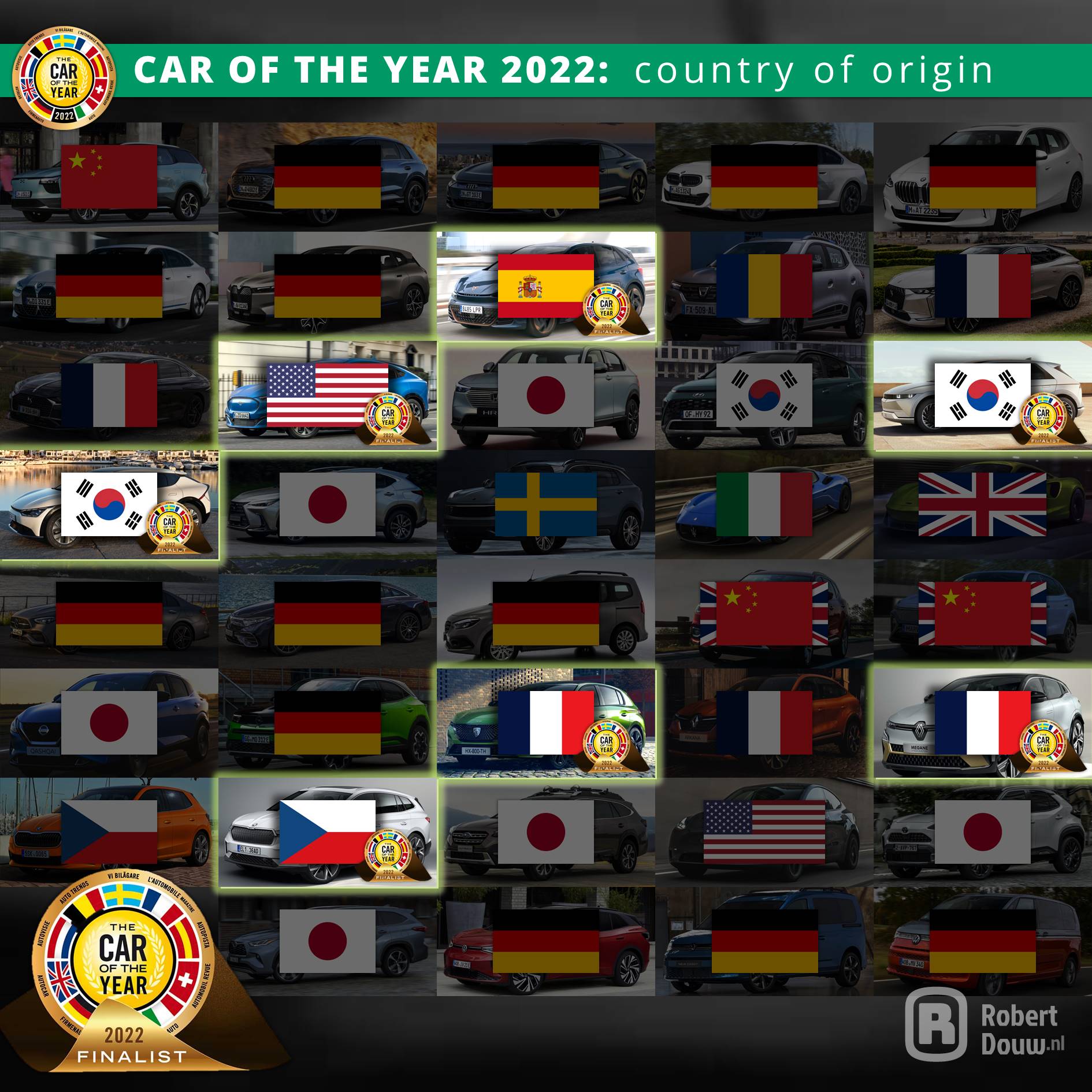
If you look at the longlist for the Car of the Year 2022, you can clearly see just how remarkable it is. Thirteen of the 39 cars on that list are of German origin - not one of them made it to the final. Six of the 39 are of Japanese origin - none of them are in the final either.
If you look at the origin of all car brands worldwide, the vast majority of them originate in China. And while the Chinese brands are increasingly finding their way into the European car market and some of the cars on the longlist could be classified as Chinese, they are not in the final of the Car of the Year 2022.
The most painful absences on the shortlist and longlist are perhaps the Italian brands. Fiat is title holder in the number of victories in the European Car of the Year election, Alfa Romeo and Lancia are both in the Top 10 of the Top 50, but there is no trace of all these brands in 2022...

CAR OF THE YEAR 2022
Seven cars, five platforms
Cars
| 12-01-2022
For almost as long as cars have existed, technology has been shared by car builders. Due to increased demands from both governments and consumers and to the transition to electrically powered cars, development costs have increased in recent years. As a result, technology is now shared on a much larger scale than in the past. For many concerns, this has even become part of their strategy.
A textbook example of technology sharing is Stellantis, which can spread its development costs over as many as fifteen car brands. For example, the Peugeot 308 shares a lot with, among others, the DS 4 and the Opel Astra. A total of 27 different models are being built on the EMP2 platform. Similarly, the Hyundai IONIQ 5 and Kia EV6 share their platform with the Genesis GV60.
However, Volkswagen AG also is pretty good at it: there are already nine different models from Audi, Cupra (the Born), Škoda (the Enyaq iV) and Volkswagen on the MEB platform, and there are many more in the pipeline. I'm a bit surprised the Cupra Born made it to the final, because it is very clearly a variant of the Volkswagen ID.3 that finished fourth last year. Previously, such projects were seen as one model; think of the Chevrolet Volt and Opel Ampera, for example.
The only finalist that (for now) is the only one on a new electric platform, is the Ford Mustang Mach-E. Although, new; that platform is a significant further development of the basis on which very diverse models of Ford and Lincoln have been built for years. And Ford Motor Company will no doubt not be using the platform exclusively for the Mustang Mach-E.
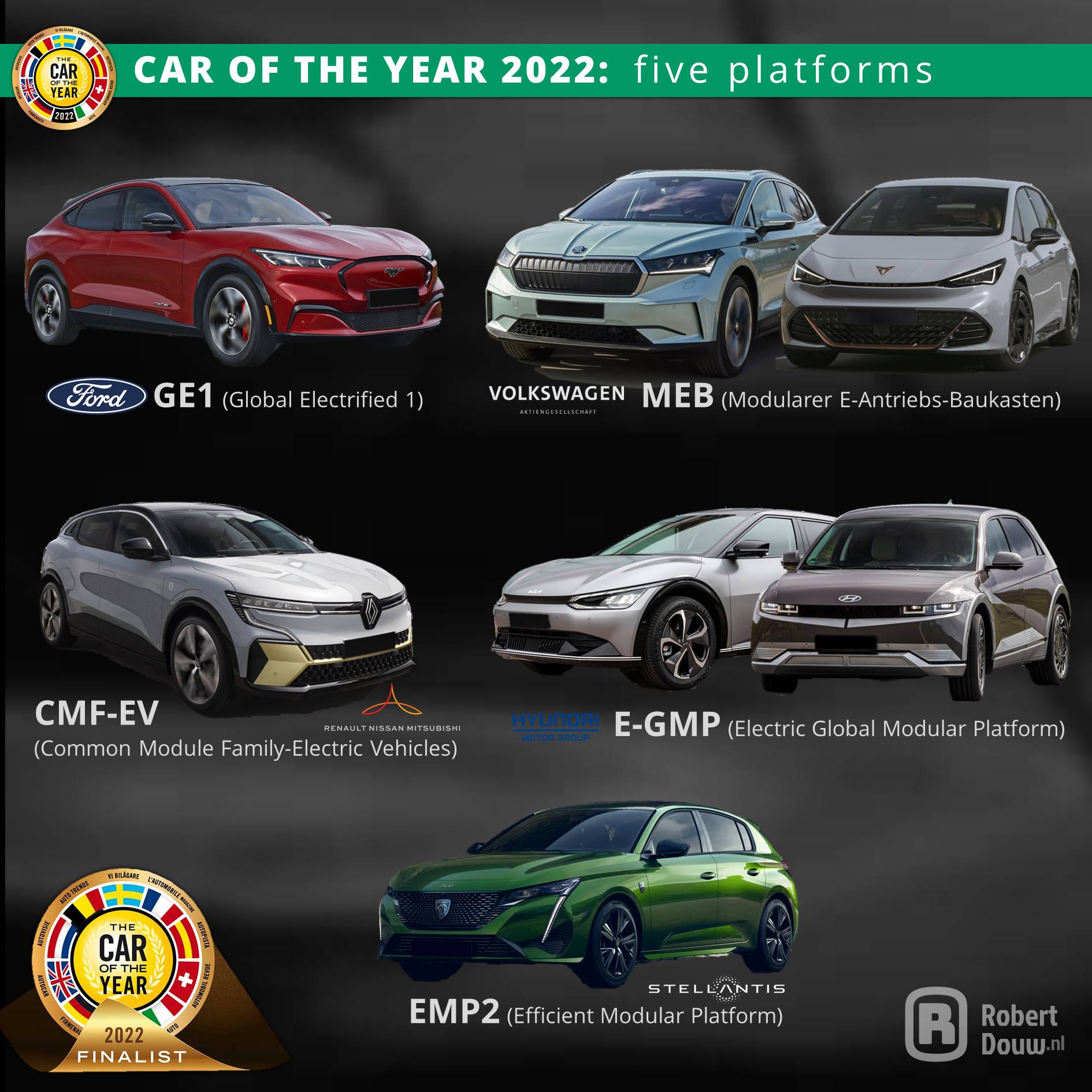
A textbook example of technology sharing is Stellantis, which can spread its development costs over as many as fifteen car brands. For example, the Peugeot 308 shares a lot with, among others, the DS 4 and the Opel Astra. A total of 27 different models are being built on the EMP2 platform. Similarly, the Hyundai IONIQ 5 and Kia EV6 share their platform with the Genesis GV60.
However, Volkswagen AG also is pretty good at it: there are already nine different models from Audi, Cupra (the Born), Škoda (the Enyaq iV) and Volkswagen on the MEB platform, and there are many more in the pipeline. I'm a bit surprised the Cupra Born made it to the final, because it is very clearly a variant of the Volkswagen ID.3 that finished fourth last year. Previously, such projects were seen as one model; think of the Chevrolet Volt and Opel Ampera, for example.
The only finalist that (for now) is the only one on a new electric platform, is the Ford Mustang Mach-E. Although, new; that platform is a significant further development of the basis on which very diverse models of Ford and Lincoln have been built for years. And Ford Motor Company will no doubt not be using the platform exclusively for the Mustang Mach-E.

CAR OF THE YEAR 2022
Drive: almost all electric
Cars
| 19-01-2022
Mach-E, IONIQ, EV6, E-TECH Electric – the automotive industry is relying on electric propulsion en masse and consumers will know this too. Of the electric finalists, only Cupra and Škoda are a bit more neutral; with iV, the latter does have a special label for electrically powered models, but most consumers will not (yet) recognize it as such. It's a clear sign that six of the seven finalists are only available as EV.
It is not news in itself that electricity will become the 'fuel' of the future – this development has been going on for much longer. What ís new, is the Climate Agreement, which states that from 2030 only electric passenger cars will be for sale new. It could just be that the organization of the Car of the Year has been extra encouraged by that to nominate mainly electrically powered models of the more mainstream brands as a finalist.
Figures from the ACEA show that in countries such as the Netherlands, Luxembourg, Germany, Portugal and Austria it will probably be fine with the infrastructure of charging stations, which of are necessary to be able to implement the passenger car agreement from the Climate Agreement. In countries such as Lithuania, Greece, Poland, Latvia and Romania, however, the situation is very different. That's pretty much in line with the distribution of votes for the 2021 Car of the Year. And that's why I think the only not fully electric finalist, the Peugeot 308, has a good chance of winning the 2022 title.
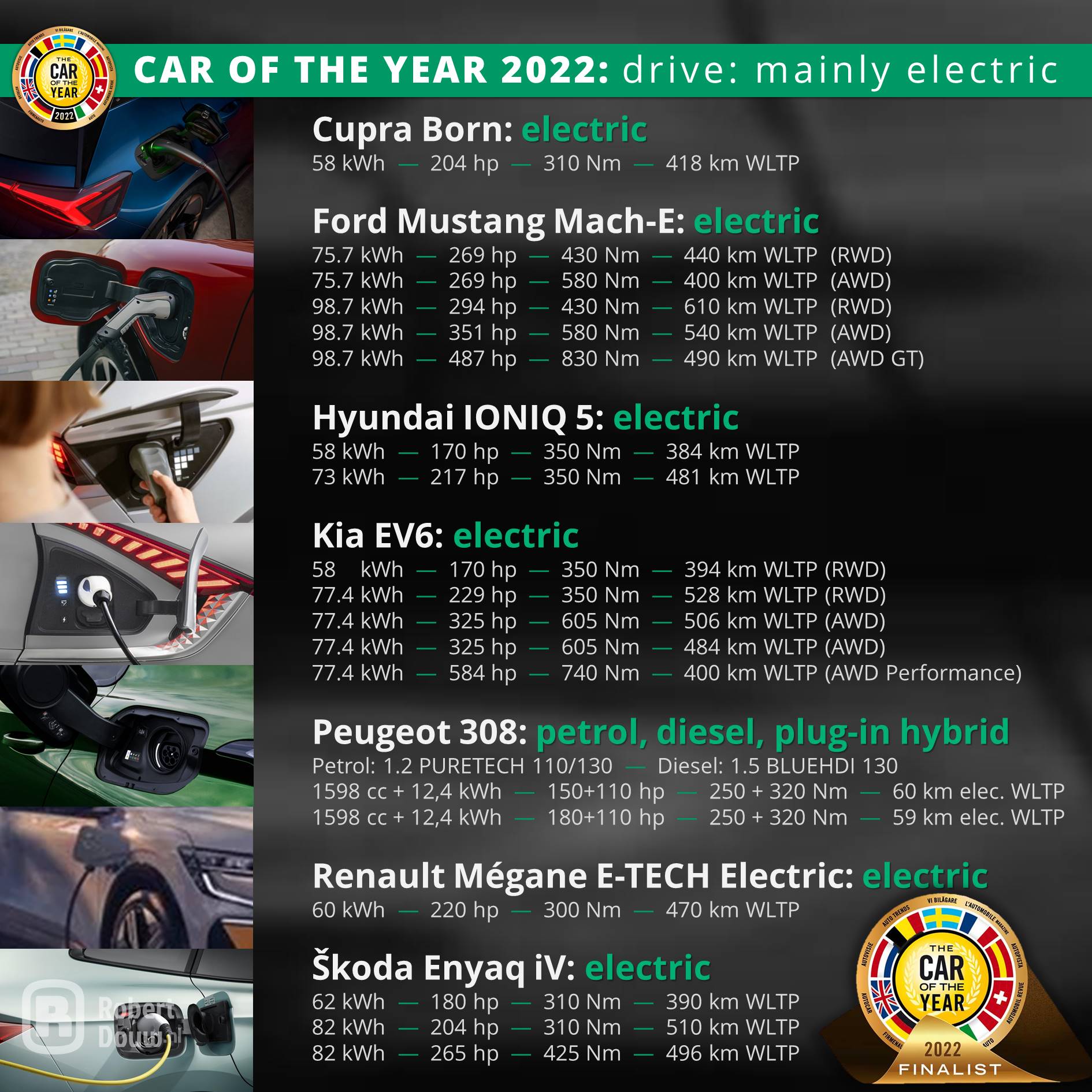
It is not news in itself that electricity will become the 'fuel' of the future – this development has been going on for much longer. What ís new, is the Climate Agreement, which states that from 2030 only electric passenger cars will be for sale new. It could just be that the organization of the Car of the Year has been extra encouraged by that to nominate mainly electrically powered models of the more mainstream brands as a finalist.
Figures from the ACEA show that in countries such as the Netherlands, Luxembourg, Germany, Portugal and Austria it will probably be fine with the infrastructure of charging stations, which of are necessary to be able to implement the passenger car agreement from the Climate Agreement. In countries such as Lithuania, Greece, Poland, Latvia and Romania, however, the situation is very different. That's pretty much in line with the distribution of votes for the 2021 Car of the Year. And that's why I think the only not fully electric finalist, the Peugeot 308, has a good chance of winning the 2022 title.

CAR OF THE YEAR 2022
All five-door cars
Cars
| 26-01-2022
All the finalists for the 2022 Car of the Year title are five-door cars, and also only available with five doors (i.e. four doors and a hatchback). That has never happened before. Three-door hatchbacks, four-door sedans, two-door coupes – once they were common body styles – you see them less and less.
This year's longlist also featured mostly five-door models, so there's more to it than the jury's selection. A good time to look at the long term. This goes back to 1963 in the Car of the Year. If you look at it per decade, a clear trend is visible, even though the figures are rounded and approximate:
- 1960s: ca. 8% of the finalists are five-door
- 1970s: ca. 17% of the finalists are five-door
- 1980s: ca. 23% of the finalists are five-door
- 1990s: ca. 33% of the finalists are five-door
- 2000s: ca. 62% of the finalists are five-door
- 2010s: ca. 68% of the finalists are five-door
- 2020s: ca. 90% of the finalists are five-door
So there seems to be a clear trend here. And although I myself also have a five-door car, because it is very practical, I think the trend is a bit of a pity. Each bodytype has its own charms, so with only five-door cars, a lot of charm is lost.
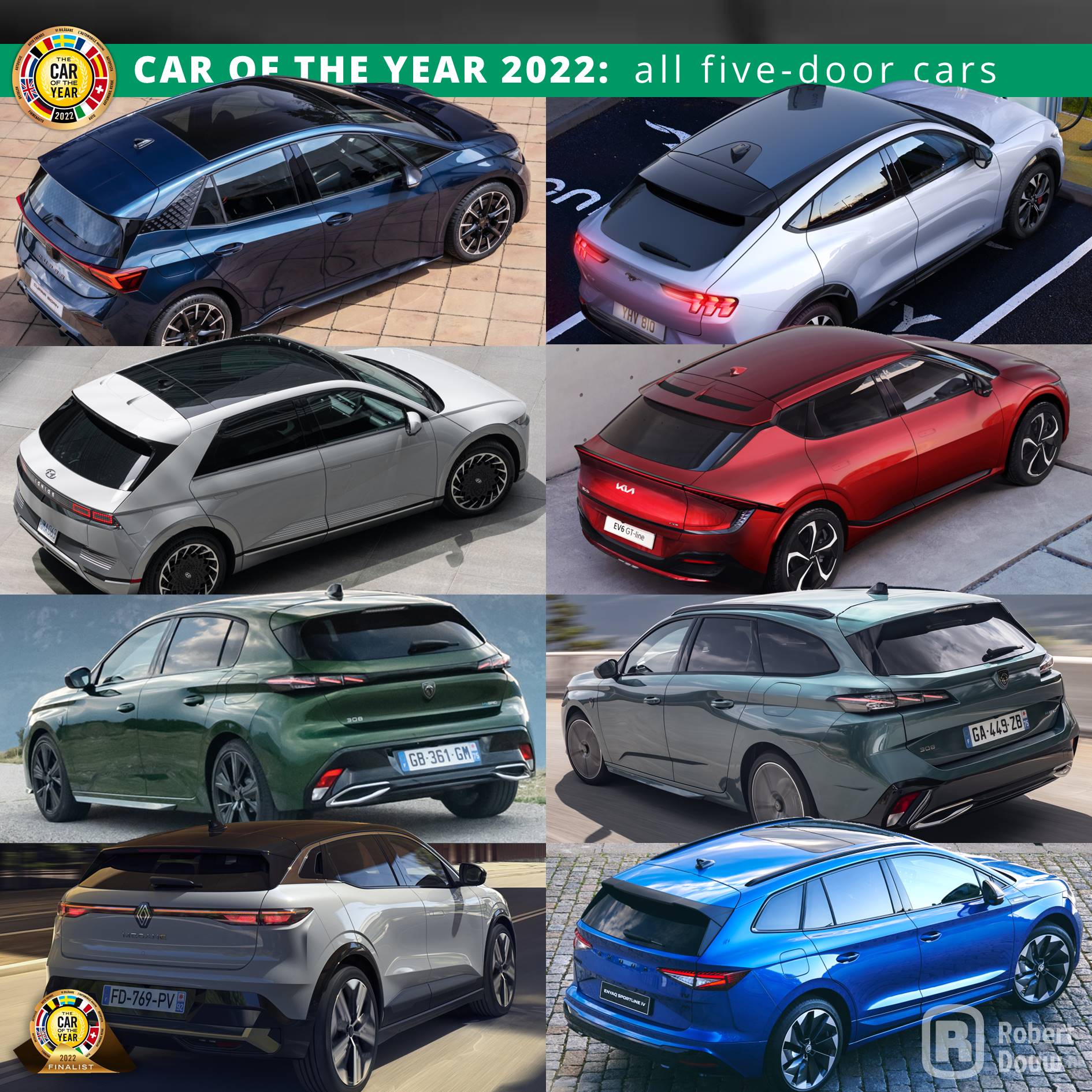
This year's longlist also featured mostly five-door models, so there's more to it than the jury's selection. A good time to look at the long term. This goes back to 1963 in the Car of the Year. If you look at it per decade, a clear trend is visible, even though the figures are rounded and approximate:
- 1960s: ca. 8% of the finalists are five-door
- 1970s: ca. 17% of the finalists are five-door
- 1980s: ca. 23% of the finalists are five-door
- 1990s: ca. 33% of the finalists are five-door
- 2000s: ca. 62% of the finalists are five-door
- 2010s: ca. 68% of the finalists are five-door
- 2020s: ca. 90% of the finalists are five-door
So there seems to be a clear trend here. And although I myself also have a five-door car, because it is very practical, I think the trend is a bit of a pity. Each bodytype has its own charms, so with only five-door cars, a lot of charm is lost.

CAR OF THE YEAR 2022
Only 308 and Mégane have predecessors
Cars
| 02-02-2022
Typically, the majority of the Car of the Year finalists are models that are successors to a previous model; sometimes that even applies to all finalists. This year, however, it is very different: only two models are a new generation of an existing model.
Of those successors, even only the Peugeot 308 is a hatchback or station wagon like the previous 308. The Mégane E-TECH Electric bears the name of the hatchback that it succeeds, but is more of a crossover between a hatchback and an SUV. This year's other finalists are all new additions to their brand's model range. That has everything to do with the aforementioned electrification of the range of cars. So a sign of the times.

Of those successors, even only the Peugeot 308 is a hatchback or station wagon like the previous 308. The Mégane E-TECH Electric bears the name of the hatchback that it succeeds, but is more of a crossover between a hatchback and an SUV. This year's other finalists are all new additions to their brand's model range. That has everything to do with the aforementioned electrification of the range of cars. So a sign of the times.

Swipe the image below to view it in large.
CAR OF THE YEAR 2022
Cupra: 2nd own design, 2nd finalist
Cars
| 13-02-2022
In the 1990s, when Ferdinand Piëch held sway at Volkswagen, I read in AutoBild magazine how he was said to position the VW Group's brands. If I remember correctly, Audi was put opposite to BMW, Volkswagen to Mercedes-Benz, Škoda to Volvo and Seat to Alfa Romeo. Alfa Romeo designer Walter de Silva was recruited to Seat and extra sporty versions were introduced under the Cupra name. Despite this, Seat never really became the Alfa Romeo of the VW group. Upgrading sports label Cupra to an independent brand could be an attempt to achieve that after all.
Be that as it may, the Cupra brand, as a producer of its "own" models, is one of the youngest players on the market. Apart from the Leon, a model that Cupra shares with Seat, the brand has only launched two models yet. First the Formentor, which was nominated last year for the title Car of the Year, and then the Born, which is one of the finalists this year. Second own design, second finalist. Quite an achievement!

Be that as it may, the Cupra brand, as a producer of its "own" models, is one of the youngest players on the market. Apart from the Leon, a model that Cupra shares with Seat, the brand has only launched two models yet. First the Formentor, which was nominated last year for the title Car of the Year, and then the Born, which is one of the finalists this year. Second own design, second finalist. Quite an achievement!

CAR OF THE YEAR 2022
Ford: six times in the CotY Top 50
Cars
| 16-02-2022
Ford is an American car brand with a special history in Europe. This can be clearly seen in the annals of the European Car of the Year election, in which American brands generally appear very little. Chevrolet reached the final once and then also won, but with a model – the Volt – which was also sold by the German brand Opel and the British brand Vauxhall. Chrysler also got to to call itself a finalist only once. That manufacturer won the 1979 title with the Horizon. The Simca-Chrysler Horizon. Developed by Chrysler Europe. Other American brands such as Buick, Cadillac, Dodge, GMC, Jeep, Lincoln, Mercury, Oldsmobile, Plymouth and Pontiac never made it to the finals in the European election. This is in contrast to Ford.
Ford won the European title a total of five times. That's as much as Opel, and more than the top-selling car brands Toyota and Volkswagen. In fact, only Fiat, Peugeot and Renault have won the title more times. In total, Ford reached a final place 27 times (including this year). That has led to a place in the best three so far sixteen times. Moreover, Ford won several times with high scores: in the Top 50 you will encounter six Fords, the Focus is even in fourth place. Why is Ford doing so much better in Europe than other American brands? I think that's because Ford feels less American to many Europeans than other US brands. Ford may even feel European. Because it is a bit European.
As early as 1909, Ford established a subsidiary in Great Britain, which would later become known as Ford of Britain. In 1917 Henry Ford & Son Ltd in Ireland followed, and in 1925 Ford-Werke GmbH, also known as Ford Germany. Since 1967, these three companies together form Ford of Europe. And you guessed it: almost all Fords that made it to the European Car of the Year finals were developed by Ford's European subsidiary. The only exception is the Mustang, which finished third in 1964 and tenth in 1973. Would the Mach-E be the first Ford Mustang to win the title?
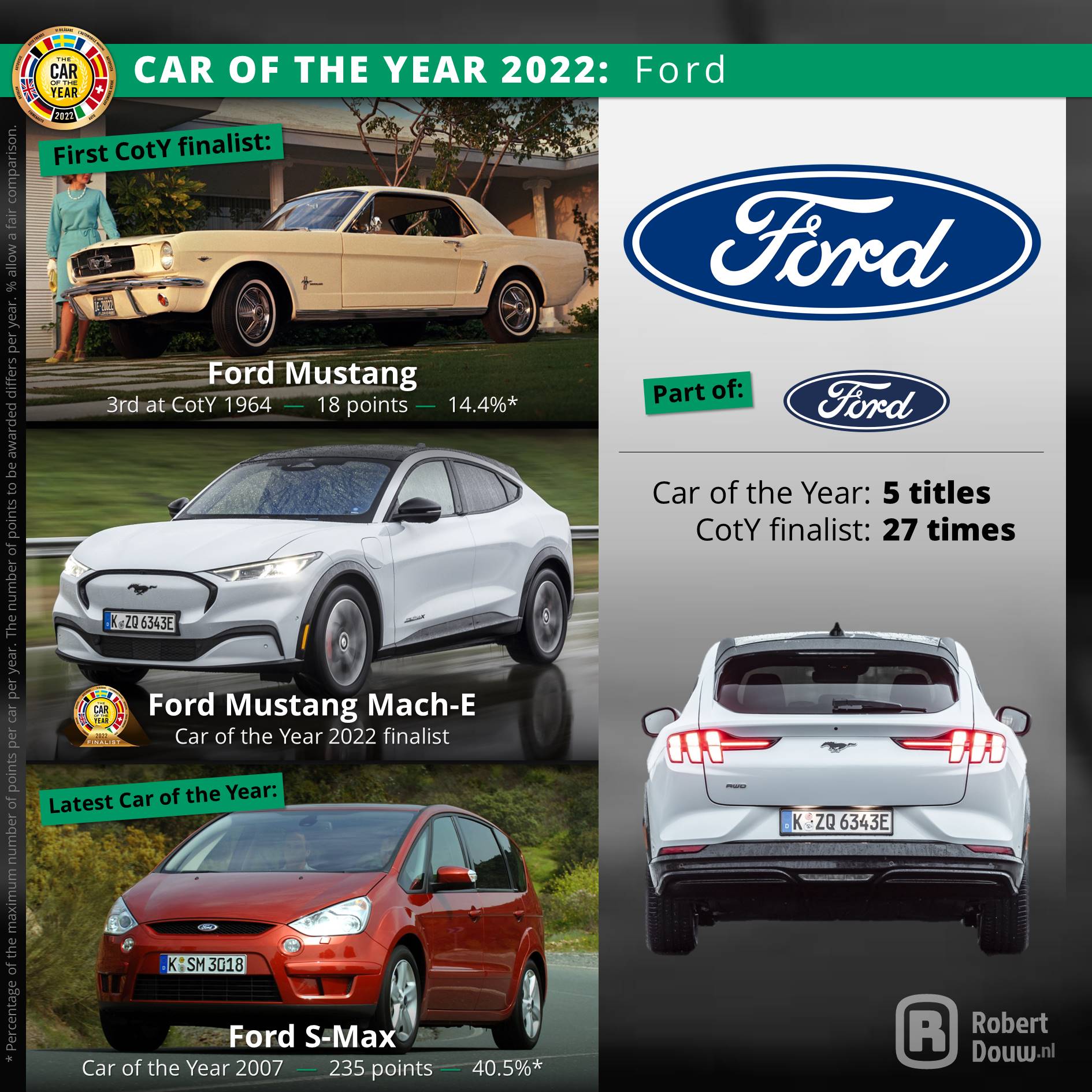
Ford won the European title a total of five times. That's as much as Opel, and more than the top-selling car brands Toyota and Volkswagen. In fact, only Fiat, Peugeot and Renault have won the title more times. In total, Ford reached a final place 27 times (including this year). That has led to a place in the best three so far sixteen times. Moreover, Ford won several times with high scores: in the Top 50 you will encounter six Fords, the Focus is even in fourth place. Why is Ford doing so much better in Europe than other American brands? I think that's because Ford feels less American to many Europeans than other US brands. Ford may even feel European. Because it is a bit European.
As early as 1909, Ford established a subsidiary in Great Britain, which would later become known as Ford of Britain. In 1917 Henry Ford & Son Ltd in Ireland followed, and in 1925 Ford-Werke GmbH, also known as Ford Germany. Since 1967, these three companies together form Ford of Europe. And you guessed it: almost all Fords that made it to the European Car of the Year finals were developed by Ford's European subsidiary. The only exception is the Mustang, which finished third in 1964 and tenth in 1973. Would the Mach-E be the first Ford Mustang to win the title?

CAR OF THE YEAR 2022
Hyundai and Kia: first winner from South Korea?
Cars
| 20-02-2022
Hyundai Motor Company, founded in 1967, began with assembling the Ford Cortina. Hyundai's first self-developed model was the Pony designed by Giugiaro, which was presented at the 1974 Geneva Motor Show. It was not until 1978 that the model came to the first European markets: Belgium, the Netherlands, Spain and Greece. Great Britain followed in 1982, Germany in 1991 and France in 1992. That may explain why Hyundai only reached the final of the Car of the Year in 1990 for the first time. Incidentally, with little success: the Sonata became 14th, with only 2 points. In comparison: the Citroën XM won that year with 390 points.
Kia also started in the car industry with assembling cars of other brands. The brand did this from 1974 until political pressure forced them to stop in 1981. In 1986, Kia returned to the automotive industry, partnering with Ford, which had a share in Kia. Because Ford also had the largest share in Mazda, it was able to have Kia build Mazdas under license. The 1992 Sephia was Kia's first self-developed model. Around that time, the brand also came to Europe. In 1998, Hyundai took a majority share in Kia, outbidding Ford. If they had known at Ford how much competition they would face from the South Korean brands…
Although Kia came close with the Ceed in 2019, neither South Korean brand has ever won the European Car of the Year title. But Hyundai and Kia have experienced tremendous growth in a relatively short period of time, not least in the quality of their products. This is not only underlined by the regular appearance of, for example, the Kia Niro in lists of best-selling models, but also by two of the five contenders for the title Car of the Year this year being from a South Korean brand. You can no longer ignore Hyundai and Kia.
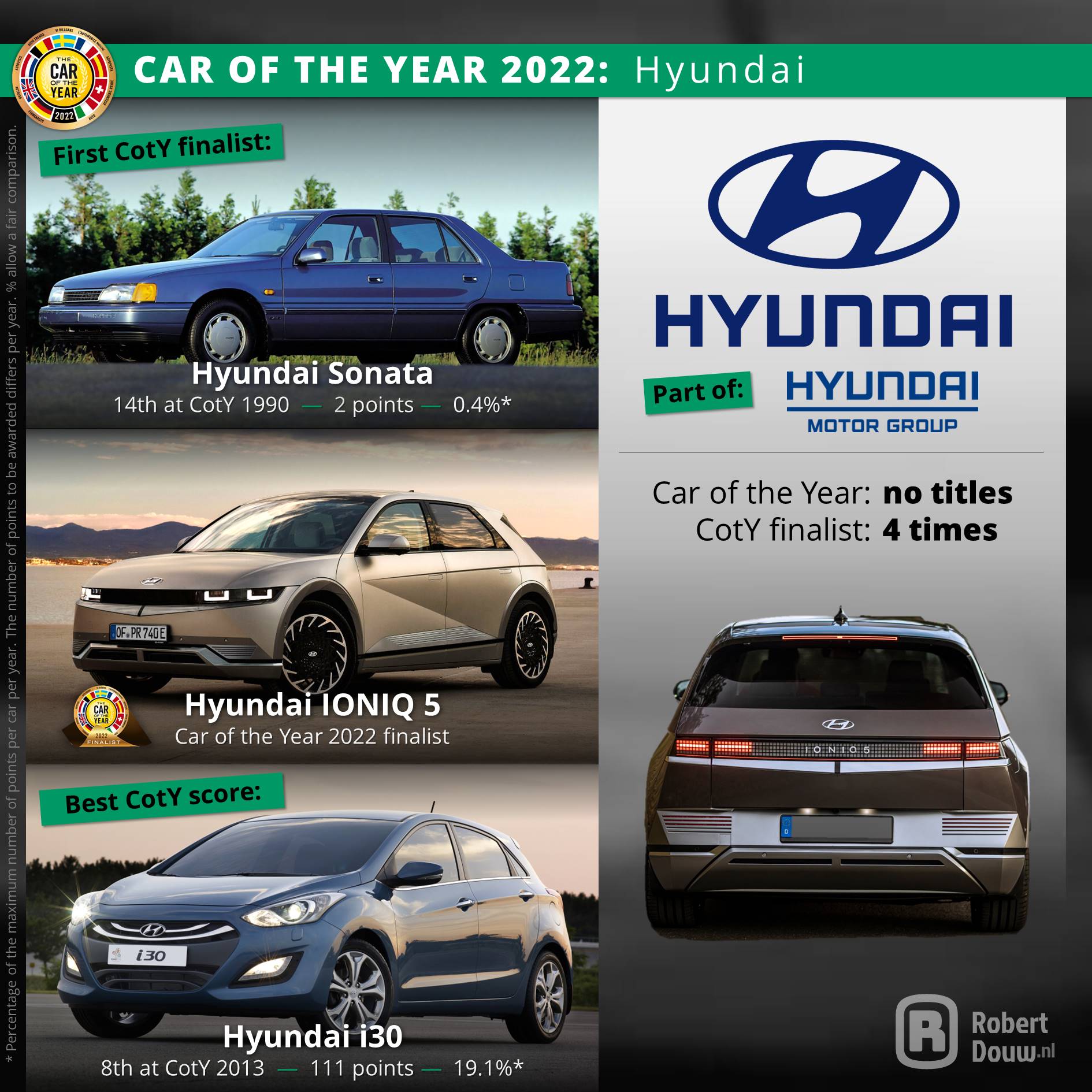
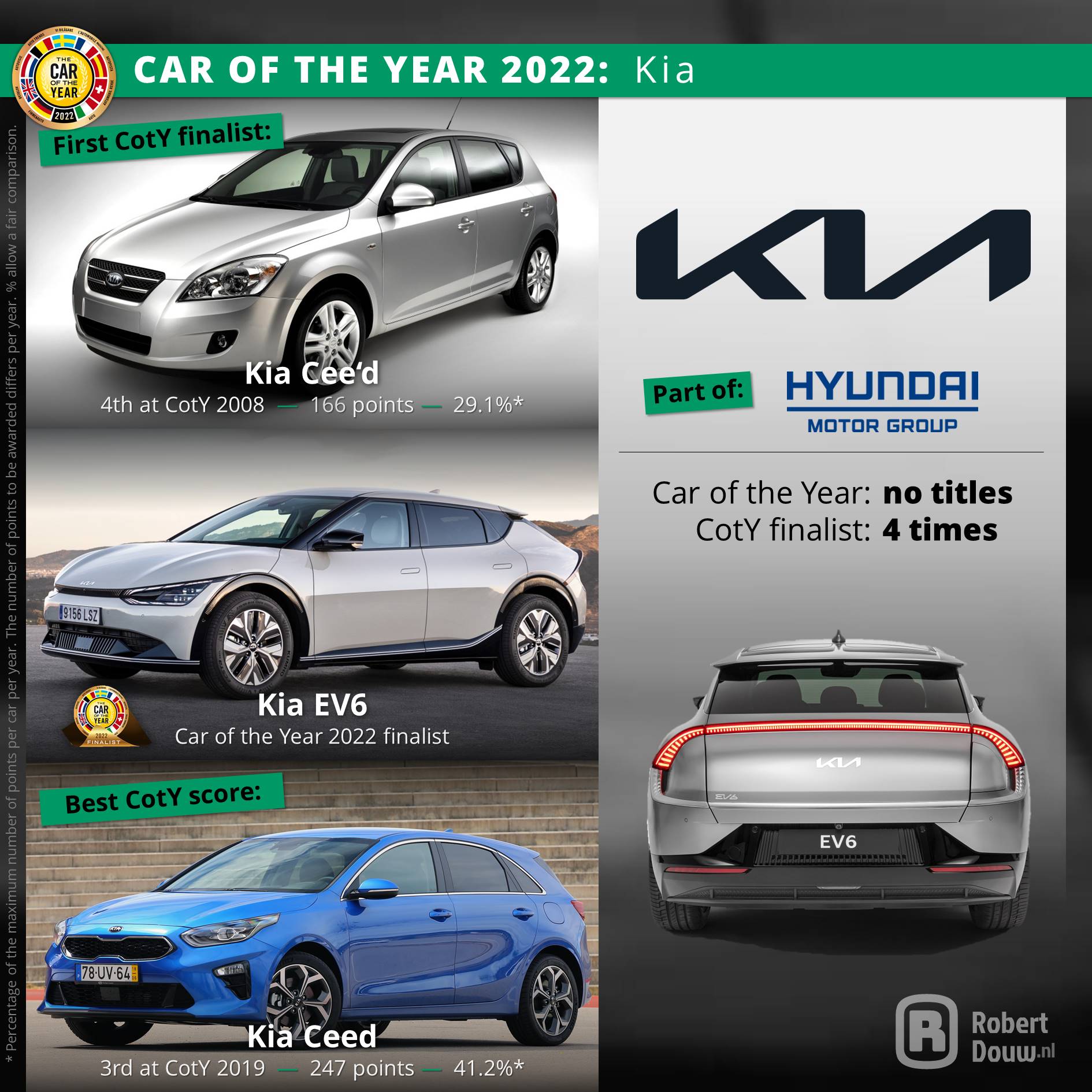
Kia also started in the car industry with assembling cars of other brands. The brand did this from 1974 until political pressure forced them to stop in 1981. In 1986, Kia returned to the automotive industry, partnering with Ford, which had a share in Kia. Because Ford also had the largest share in Mazda, it was able to have Kia build Mazdas under license. The 1992 Sephia was Kia's first self-developed model. Around that time, the brand also came to Europe. In 1998, Hyundai took a majority share in Kia, outbidding Ford. If they had known at Ford how much competition they would face from the South Korean brands…
Although Kia came close with the Ceed in 2019, neither South Korean brand has ever won the European Car of the Year title. But Hyundai and Kia have experienced tremendous growth in a relatively short period of time, not least in the quality of their products. This is not only underlined by the regular appearance of, for example, the Kia Niro in lists of best-selling models, but also by two of the five contenders for the title Car of the Year this year being from a South Korean brand. You can no longer ignore Hyundai and Kia.


CAR OF THE YEAR 2022
Peugeot: three recent models are CotY
Cars
| 22-02-2022
Peugeot is a brand with a rich history, as shown above and here (where I also tell more about the new 308). It is the second oldest existing passenger car manufacturer. And yet three of the six Peugeots that ever won the Car of the Year title are models from the past ten years and only two are from the last century. Incidentally, one of these is the car that has ever received the most points ever in the history of the European election. But it is mainly recent models that have won high marks: the previous 308, the 3008 and the 208. The new 308 – my favorite – continues the line that has been started with those models, and in many ways goes a step further. The question is, of course, whether that is enough to convince the jury again this year, especially given the strong competition. Will the new 308 match the success of its predecessor?
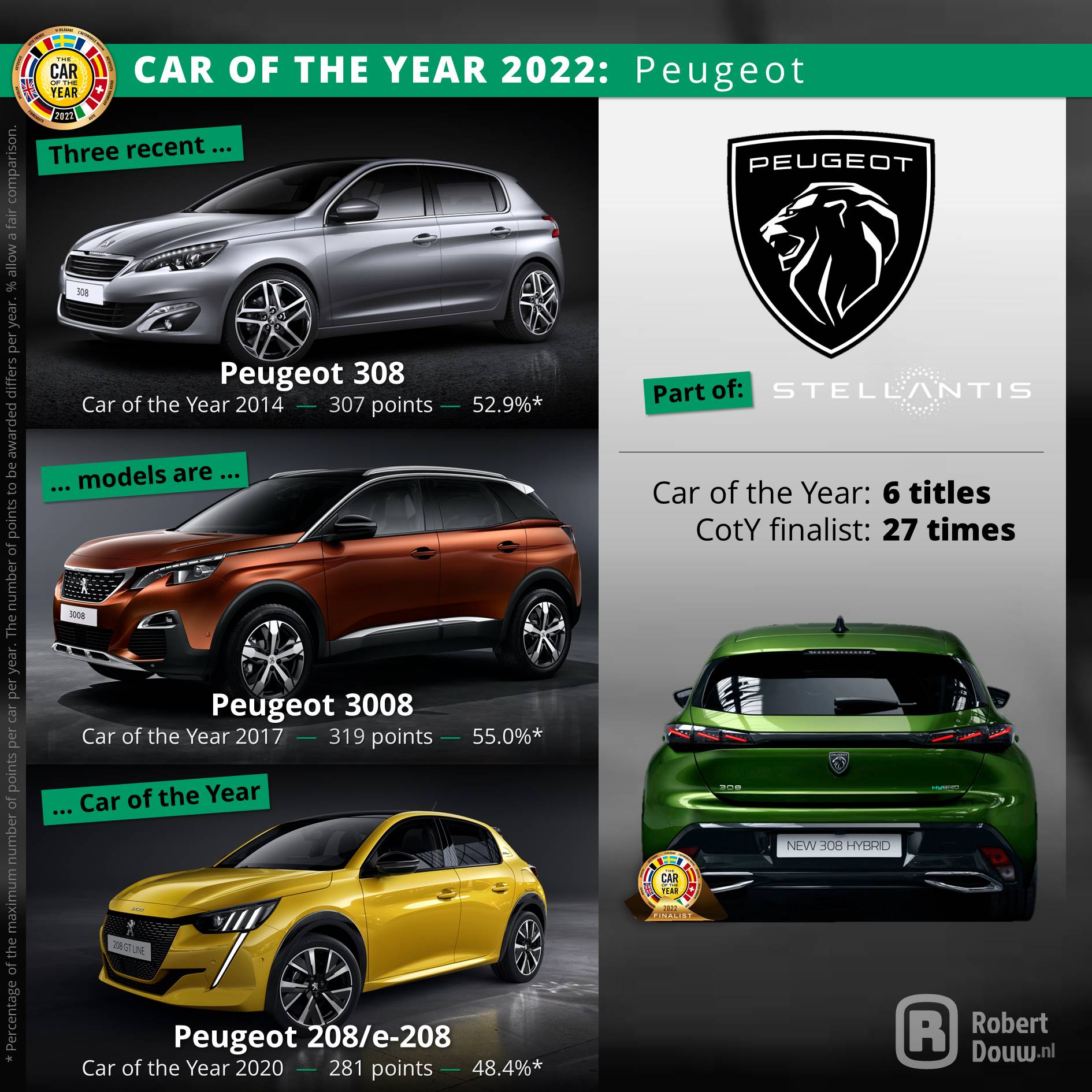

CAR OF THE YEAR 2022
Renault: MPV, hatchback, crossover
Cars
| 24-02-2022
Like Peugeot, Renault as a brand with an extensive heritage. A production model called Mégane has played a role in this since 1995 (in 1988 Renault showed a concept car with the same name). In the history of the European Car of the Year we come across four models with the name Renault Mégane. That in itself is special, but what makes it even more unusual is that those models have three different body shapes.
The first Mégane that got to call itself Car of the Year was the Mégane Scénic. That was a compact people carrier, also called a Compact MPV, which was a (relatively) new segment at the time. The Compact MPV is now as good as extinct. The next Mégane to win the title had a more common body shape, being a hatchback. Yet there was little common about the shape Renault gave it in 2002, especially when viewed from behind. This in contrast to its successor, which came seventh in the 2009 election. And now there's the Mégane E-TECH Electric, of which the body is best described by the somewhat vague term crossover; it's not a traditional hatchback, but it's not an SUV either. What it might become, is the third Mégane to call itself Car of the Year.
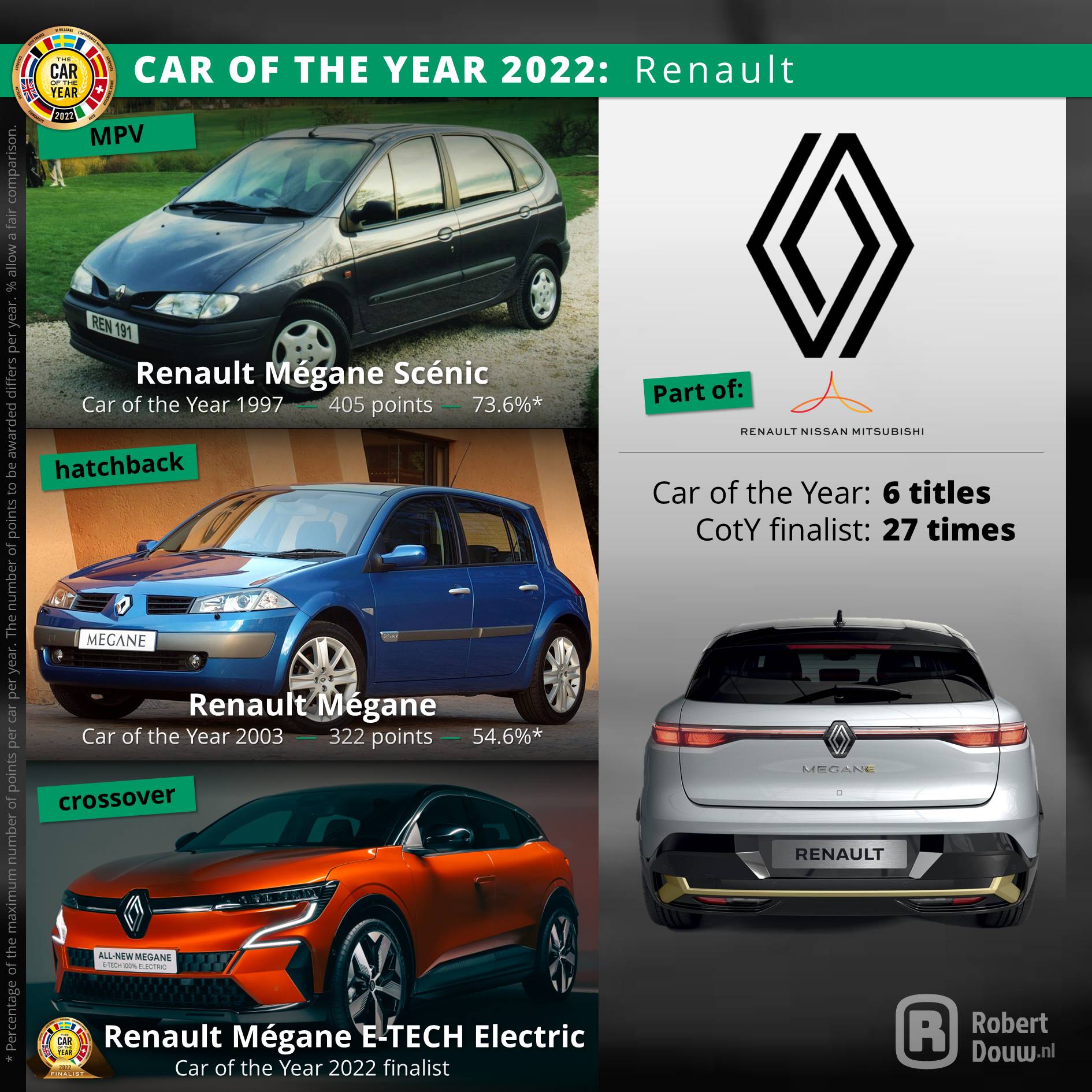
The first Mégane that got to call itself Car of the Year was the Mégane Scénic. That was a compact people carrier, also called a Compact MPV, which was a (relatively) new segment at the time. The Compact MPV is now as good as extinct. The next Mégane to win the title had a more common body shape, being a hatchback. Yet there was little common about the shape Renault gave it in 2002, especially when viewed from behind. This in contrast to its successor, which came seventh in the 2009 election. And now there's the Mégane E-TECH Electric, of which the body is best described by the somewhat vague term crossover; it's not a traditional hatchback, but it's not an SUV either. What it might become, is the third Mégane to call itself Car of the Year.

CAR OF THE YEAR 2022
Škoda: he who laughs last...
Cars
| 27-02-2022
The Škoda brand was founded in 1859, but the modern Škoda essentially dates from 1991. Then Volkswagen took a 30% stake in the brand, which would increase to 100% by 2000, with the promise to introduce new, modern models under the Škoda brand name. And Volkswagen kept its word. The first all-new model for Škoda was the 1996 Octavia, which shared its technical base with the then-to-be-released Golf IV. The Octavia marked the new beginning, which was underlined by the Dutch importer with an unmistakable print campaign: on the right were Škodas such as the 1000, 100/110 and the shown below 105/120 mentioned by name, while on the left was a larger photo of the new Octavia, with below it the text laughed enough.
The Octavia was a success and became one of the most important models for Škoda to this day. The Octavia hatchback never reached the sales numbers of the Golf hatchback, but the Octavia Combi has always outsold the estate variant of the Golf. In 2021, the Octavia Combi even was the best-selling wagon in Europe. And now Škoda seems to have another hit: the Enyaq iV, the brand's first electric car. In 2021, the Enyaq iV was the seventh best-selling electric vehicle (BEV) in Europe and even the best-selling in five markets, with the first cars not being delivered to customers until April or May. So 2022 will be the first full year of sales for the Enyaq iV and the outlook is good. The addition of the Enyaq Coupé iV makes the future all the more promising for Škoda. Where Škoda entered the phase of "laughed enough" with the first modern Octavia, the potential Car of the Year 2022 may be the start of the next phase: he who laughs last...
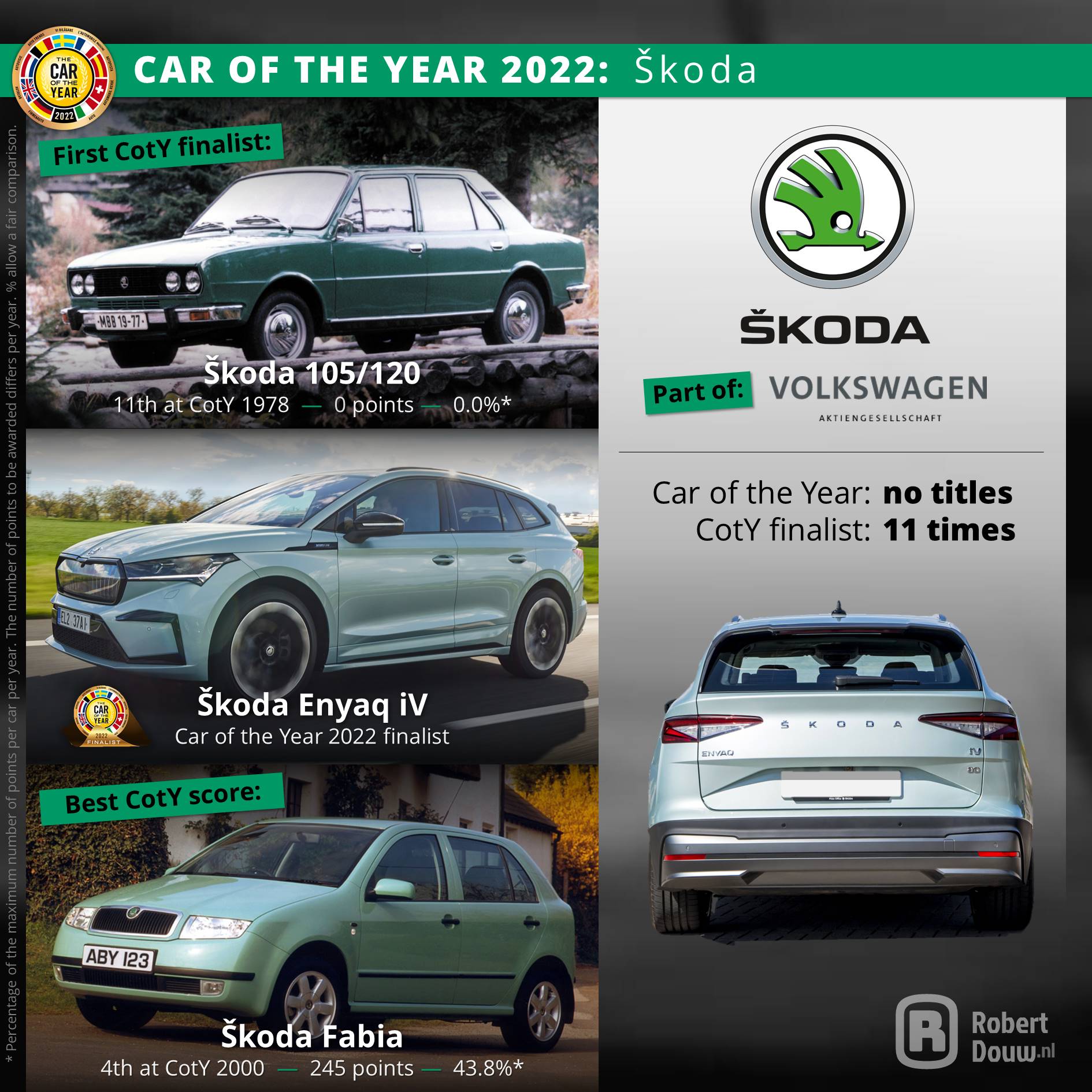
The Octavia was a success and became one of the most important models for Škoda to this day. The Octavia hatchback never reached the sales numbers of the Golf hatchback, but the Octavia Combi has always outsold the estate variant of the Golf. In 2021, the Octavia Combi even was the best-selling wagon in Europe. And now Škoda seems to have another hit: the Enyaq iV, the brand's first electric car. In 2021, the Enyaq iV was the seventh best-selling electric vehicle (BEV) in Europe and even the best-selling in five markets, with the first cars not being delivered to customers until April or May. So 2022 will be the first full year of sales for the Enyaq iV and the outlook is good. The addition of the Enyaq Coupé iV makes the future all the more promising for Škoda. Where Škoda entered the phase of "laughed enough" with the first modern Octavia, the potential Car of the Year 2022 may be the start of the next phase: he who laughs last...

CAR OF THE YEAR 2022
The winner!
Cars
| 28-02-2022
The winner is known! The Kia EV6 has been named the European Car of the Year 2022. The jury awarded that model a total of 279 points, which is equal to 47.3% of the maximum votes that can be obtained per model. This puts the model in 76th place in the historical ranking of the election and therefore not in the Top 50. Browse through the images below to see the full 2022 results.
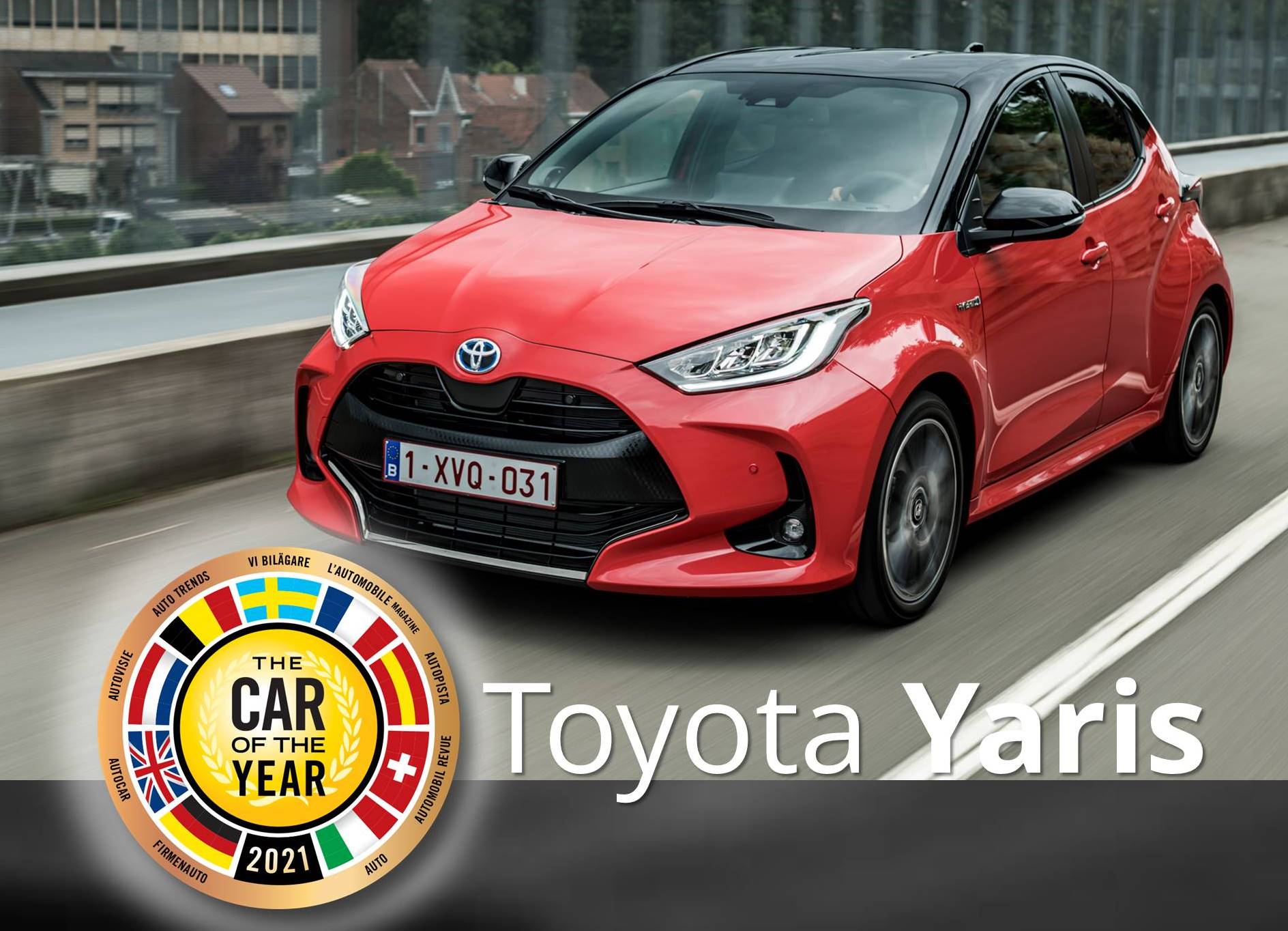
CAR OF THE YEAR 2021
This is the Car of the Year 2021!
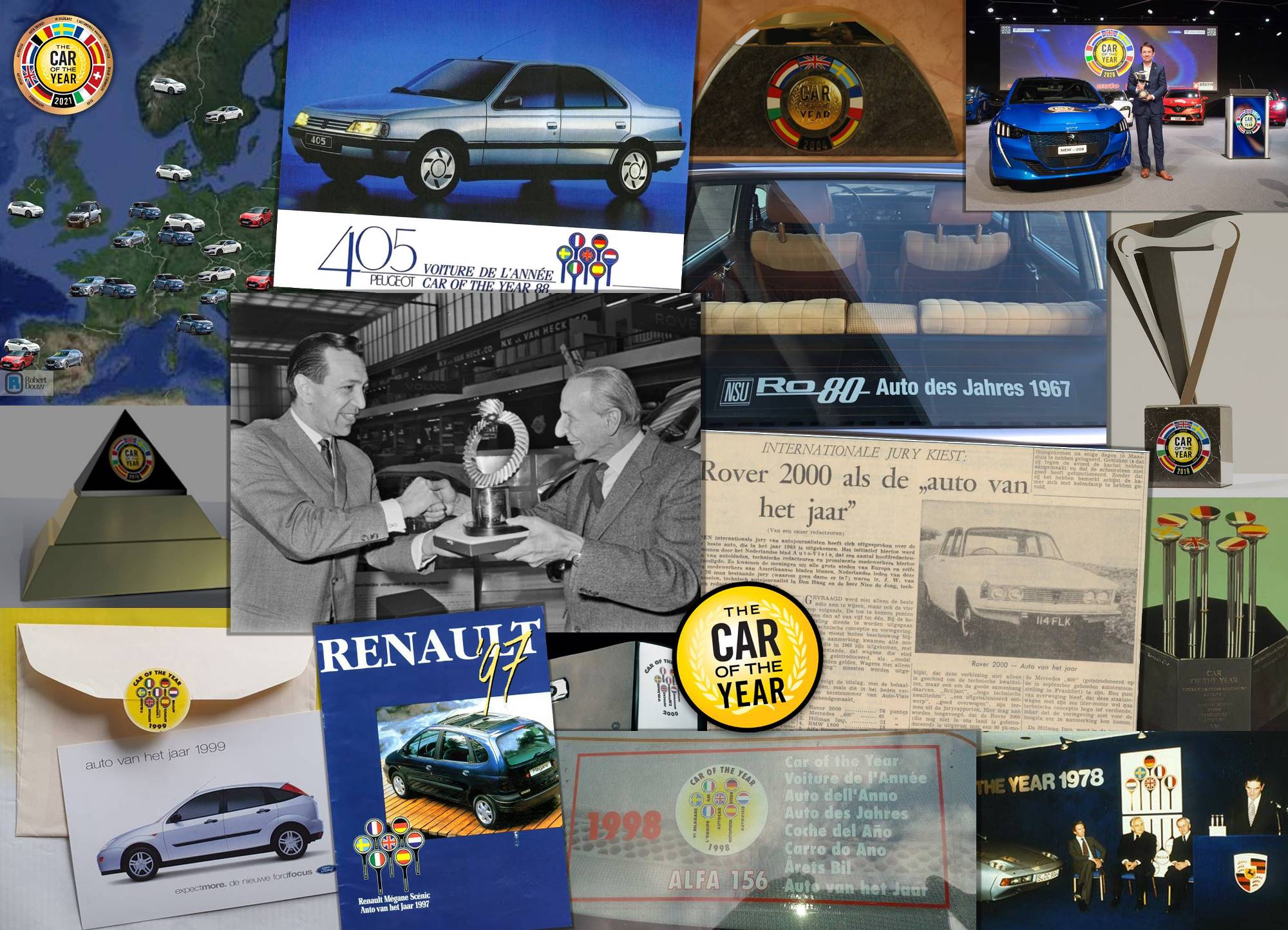
CAR OF THE YEAR TOP 50
View the entire Top 50

HERITAGE IN CAR DESIGN
Opel Astra
CARS
Click here for an overview of everything in the Cars section.
